The Travelling Veterinary Nurse
Thursday, february 25, 2021, world spay day - 2021, world spay day 2021.
Usually, a lot of us veterinary travellers would be raising awareness of this day from somewhere abroad, but in the weird time that we are in, it's a day to reflect from home on the sheer importance of neutering and trap neuter release projects. It's a day to realise just how effective and necessary these missions are, especially now, a year later when we are noticing a real change and drastic increase of numbers of stray dogs and cats abroad.


Why is neutering important?

What is happening now?
Around the world, places that have not recieved volunteer help in the past year are already seeing the effects of a lack of neutering projects. Charities and rescues are full to the brim with stray dogs and cats, numbers of strays on the streets has risen dramatically, there are puppy and kitten 'booms' and an increase in the devastating spread of diseases like calicivirus and panleukopenia which end the lives of kittens at young ages.
It is heart-breaking as a volunteer to see a lot of the hard work from so many of us be set back due to a year of not being able to help. But we must remember that this won't be forever, and that as soon as we can, we can get back on track!
All of the places I have volunteered in the past, which I assume is the same around the globe at the moment, are working their hardest to try and do as much neutering as they can but it's sometimes impossible - a big factor is time. A lot of the charities (if they are lucky enough to have a full time vet) will have their vet doing checks, treating medical inpatients, treating patients for injuries or wounds, and treating emergency admits to the rescue, as well as doing a lot of organising for rehoming, vaccinating, and basically anything and everything that keeps a rescue running - the list is endless!
This day should highlight the heroes that are doing everything they can to keep the mission alive and help keep these animals and the people in their communities safe!
What can i do to help.
If you are a member of the public, consider donating to a charity which supports TNR (Trap Neuter Release). You could either donate money, or perhaps a bag of dog or cat food, or even consider a bake sale or another fundraising event.
If you are a veterinary surgeon, or veterinary nurse or technician, depending on where in the world you are and if travel is possible at the moment, consider contacting a charity abroad and seeing if you can volunteer for them. And if you aren't able to travel at the moment, consider planning a trip for when it becomes possible!
There is a light at the end of the tunnel, and when the ban on international travel is lifted, charities will be crying out for help around the globe. If you can lend a hand, even for just a week, it would mean the world to not only the people working at the rescues full time, but the animals in their care and on the streets and the local communities.

Wednesday, April 29, 2020
Veterinary volunteering organisations and charities, in this post, myself and a few other travelling veterinary nurses have comprised a list of organisations and charities for volunteer vets and veterinary nurses.

Sunday, April 19, 2020
Why you should try solo travelling - even if it's just once, some things i get a lot - from friends, family, colleagues, strangers even, 'aren't you scared' o r , ' you're really brave' or, 'i couldn't do that ' , when i just want to shout from the rooftops, 'it's not that scary, i'm really not that brave, and you can definitely do it if you want to'.

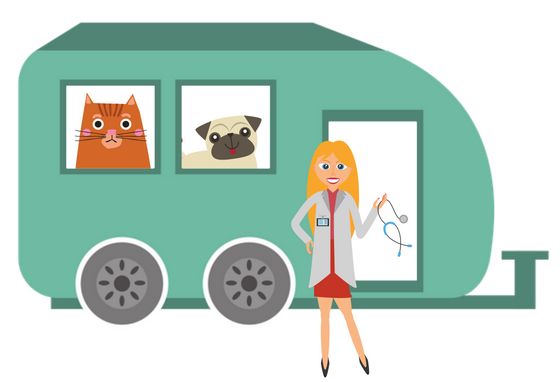
The Travelling Vet Nurse
Travelling to you, for your pets needs

Hi there, I’m Lauren the Travelling Vet Nurse!
Having been a Veterinary Nurse for more than 10 years in various clinics around Western Australia, the Travelling Vet Nurse was born when my Husband and I decided to uplift our young family from our home in Geraldton and travel around Australia for six months in our caravan.
My experience ranges from being a receptionist on the front desk, to aiding my vet in emergency surgeries as a Head Nurse. I thrive in seeing my patients improve, whether it’s from an emergency situation, a weight-loss program or just simply growing up in life.
I cannot wait to meet a whole bunch of new pets as we travel around our beautiful country!

A big thank you from naughty Jaina. I can never get her ear drops in properly and she gets really wriggly. Lauren came over and taught me a different way of distracting Jaina whilst doing the drops and I can do it on my own now! Much appreciated!

Thank you Lauren, for your recent visit for Ponyo. Ponyo hates going to the vet, so being able to have you come to my home to give her tablets was a huge help.
Thank you!!
Ponyo Loves Lauren!

- Copy shortlink
- Report this content
- Manage subscriptions
How to work abroad as a Veterinary Nurse

This article may contain affiliate links, meaning I make a small commission on any purchases at no extra expense to you. Read our disclaimer & privacy policy here.
My first passion is travelling, closely followed by my passion for animals.
These two work harmoniously together when pursuing a career abroad. I am a qualified veterinary nurse with an advanced certificate in emergency medicine and critical care. I completed my initial training in the UK and since qualifying have worked in Thailand , Australia , Kuwait, India and now South Africa. Enjoy your job and you’ll never work another day… follow me to find out how!
Know the requirements to get hired
- A level 3 diploma in Veterinary Nursing (UK qualification).
This course takes 2-4 years and can either be full-time with placements or in an apprenticeship style. The qualification is also run at degree level, as either a foundation degree or a bachelor of science at various universities across the UK. The course is challenging and requires written exams, practical exams and a portfolio to be completed.
The training is no walk in the park - it is intense yet rewarding and door-opening.
A similar degree can be obtained around the world but as I studied in the UK, that's where my expertise lies.
As a veterinary nurse who has benefited immensely from using the profession to travel, I feel it is my duty to show to the world how much this specialty has to offer in regards to globetrotting and wanderlust hunting!
We’re not a regular travel blog; we’re a collection of women living around the world, all with different backgrounds, jobs, desires, & nationalities. What do we have in common? A passion for life abroad. Each article is written from the 1st-hand perspective of a woman who has actually done or experienced what she writes about. Learn more about the author by clicking her bio pic at the start or end of each article.
Dream of moving abroad but need a helping hand? I got you. This e-book isn't a regular book, it's also a workbook geared to helping you make some big decisions regarding the life abroad you want to build. Everyone's way abroad is different. This book is all about helping you find yours.

How to obtain a job abroad
1. use recruitment websites.
Where there are animals, there are clinics. Where there are clinics there is a need for professional, trained veterinary staff. This means that veterinary nursing can take you as far as you want to wander. Not qualified as a vet but you are a nurse? Check out how to become a travel nurse and take your job all around the world.
Everyone has access to the web these days, which makes the world a much smaller and more accessible place. There are numerous recruitment sites like Vetlink , Vet Record , Vet Nurse Recruitment and my personal favourite, Kookuburra .
I found both my jobs in Thailand and Australia from this nifty gem of a recruitment website. It even arranges jobs simply by the areas of the globe you wish to visit. It ranges from charity placements to paid positions, locum to long term.
2. Schedule a video interview
Interviewing for these positions couldn’t be easier; Skype and Whatsapp video calls mean you can be in a boardroom whilst simultaneously sitting on your own sofa.
If you're specifically for jobs in Australia, by applying for the Work and Holiday visa , you'll become eligible to work and live in Australia for at least 1 year. Other working holiday visas are available for New Zealand and Japan.

3. Discuss your pay & benefits
All a gypsy heart longs for is a job they love, which accommodates for travelling, and that allows you to travel for longer on low funds.
Things to expect:
- You should not need to pay to work on a project
- You generally will have accommodation included in your package. Maybe it'll be more of a hut than the Hilton but nonetheless as it can provide a roof for a backpacker and eliminate hostel fees, it’s a win!
- It's common to receive a competitive expatriate package which includes accommodation, transport, health insurance, visa and of course flights . These packages really reduce monthly outgoings, which will in turn allow finances to be spent on what you actually want, meaning more trips.
Being based for a contracted period in an exotic spot can be of great benefit. Flights to spots that were once inaccessible due to long duration and painful costs have now become weekend getaways.
Differences working abroad as vet nurse vs. working in your home country
Veterinary nursing is a vocation that is commonly overlooked. Nurses are a crucial part of the veterinary team, their jobs include caring for patients, practice management and completing diagnostics. Nurses abroad are few and far between, which makes the UK, USA and Australian qualifications extremely desired.
Working abroad can differ hugely from working within the comfort of your motherland. Different species and diseases make for a more diverse and exciting caseload, which in turn improves job satisfaction. The veterinary profession differs hugely depending on the region, with diversity in cases, facilities, diseases and species.
Immersing yourself within the culture of your new abode is my favourite part of working abroad. Commonly the majority of staff employed will be locals, meaning you are exposed to much more of the local customs, such as language and lunchroom antics.
People sometimes worry that travel or working abroad may affect career progression, however when travelling with a profession it only accelerates your career. Travelling and gaining experience abroad is something most employers will seek, as it means the candidate has more life experience, greater maturity and an outgoing nature.
To be such a well-rounded member of staff is highly beneficial to a future employer.

Day in the life of a traveling Veterinary Nurse
No day is ever the same for a nomadic vet nurse. Commonly you will be based in the clinic focusing on anesthesia for routine procedures or complex fractures, but of course the medical cases abroad can be extremely complex, with many tropical diseases prevalent in Asia. Depending on how well equipped the clinic is, you may be performing blood transfusions on an animal with a tick-borne disease, or chemotherapy for a transmissible venereal tumor case.
South Africa is where I am based at the moment, which is home to some big pussy cats and some other majestic creatures. Commonly the veterinary team will be asked to assist with a game capture, which involves sedating an animal to either be moved to a more secure location, for administration of medication or for a general health check. The vet nurse plays a crucial role in this procedure, preparing the sedation and monitoring vital signs to determine depth of anesthesia. Hard life isn’t it just!

I couldn't image a better career choice. I urge those of you with a heart for travel and animals to consider a degree in Veterinary Nursing.
Read our disclaimer & privacy policy here .
A lot of effort went into making this amazing piece of journalistic genius. If it helped you out, send us a quick thanks by buying us a coffee. All the money donated through Ko-Fi goes towards keeping A Way Abroad awesome. Big thanks!

The ultimate resource for women dreaming of a life abroad.
.png)
How to Move Abroad
Dream of moving abroad but have some hurdles in your way? Whether it's the fear, logistics, or not knowing where to even start, I've got you. This isn't a regular book, it's also a workbook designed to help you make some big decisions to get yourself set up for a successful life abroad. Everyone's way abroad is different. Let's find yours.
.png)
Nomadic Vet: How to Become a Traveling Veterinarian
In Part Two of my series, I’ll be writing about how to become a traveling veterinarian: all the logistics I had to figure out (and still am figuring out after one year of doing this) to make my business run smoothly (you can find Part One here !).
From stethoscopes to QuickBooks
When I was in veterinary school, I was a part of the Veterinary Business Management Association. Something that I think is lacking from most vet school curriculums is an understanding of finances and business management, especially for the many who become practice owners. In school, I imagined I would ultimately own a veterinary clinic, but as I started practicing, I quickly realized that I valued my work-life balance too much to get into the high-stakes, high-stress world of practice ownership.
When I decided to start doing relief work on my own, I was able to learn and use some of those business skills in a much more low-stress way, which has been really rewarding. The logistical aspects that always seemed really scary and complicated ended up becoming very manageable and sometimes enjoyable.
Here are the steps I took to become a traveling veterinarian and what I learned along the way:
1. Relief work: a gateway to veterinary work across the country
To initially dip my toe into the relief pool, I started working for a relief veterinary group in 2021 that provided me benefits and allowed for easy scheduling at a select group of clinics. This was a great introduction to relief medicine for me, but it still required too many rules and guidelines. I wanted freedom to practice when and where I wanted!
So, when a life change took me to the other side of the country and another attempt at being an associate vet failed for me, I decided to give it a go on my own. I started off doing solo relief veterinarian gigs in local areas, never traveling more than a few hours and staying in hotels or commuting from home — I had no idea how big a part of my life this would become.
After about 6 months, I decided that I was ready to buy a van and get on the road, fulfilling my long-term dream of being a full-time traveling relief veterinarian (it does exist)!
2. Set up your own business before going on the road
When I first started operating out of California (where I was living at the time), I established my business very simply as a “sole proprietorship.” This was recommended by my accountant since it was the simplest method, and I was unsure how much revenue I’d be bringing in just starting out. This was really straightforward, I just had to register my business in the city I was based out of and provide my social security number on W9s to the clinics I was doing contract work for (or my EIN — employer identification number — which I hadn’t yet applied for).
Recently, after about a year of practicing as a “sole proprietor” relief veterinarian, I decided to form an LLC (limited liability corporation) for my business. I did this again based on the recommendation of my accountant with the main benefits being tax breaks and improved business security.
I then set up a business bank account using my EIN, and I finally started using record keeping software (QuickBooks for me) to make my expenses and income much easier to handle (I had just been using excel spreadsheets previously).
You definitely don’t need to have an accountant, but for me, it has been crucial! I find my time (and sanity) much more valuable than saving money, but that’s just personal preference. My accountant files my annual taxes in multiple states, calculates how much I need to pay in quarterly taxes, and really takes the frustrating money aspects off my to-do list.
With this big step, I was ready to start traveling across the country to work as a relief veterinarian.
3. Liability Insurance for the self-employed vet
Don’t forget about Liability Insurance! This is a crucial part of being a relief veterinarian that has luckily been made very easy by the AVMA with their PLIT coverage . I hold extra coverage above their basic plan for peace of mind. There are other options out there, but I haven’t strayed away from the tried and true PLIT myself!
4. Scheduling shifts as a traveling veterinarian
I initially thought that scheduling my shifts was going to be really stressful, but I was amazed to find it to be a really easy and enjoyable part of my job. It does require a time commitment, though, to organize my schedule, contact potential clinics, and ensure I’m working at clinics that are a good fit for me.
Initially, Roo was my biggest source for finding work and clinics, since building relationships and word of mouth can really take time! I still use Roo regularly to find clinics, especially when I’m traveling to new areas where I don't have contacts and in instances when I need to fill gaps in my schedule. Otherwise, I can generally find contacts through Facebook groups, word of mouth, and contacting clinics directly. There is such a need for veterinary relief help right now!
Generally, I prefer not to book my schedule too far out, which allows more flexibility for myself (that was the whole point of doing relief work on my own!). I generally schedule veterinary shifts about 30 to 45 days in advance, though occasionally, I’ll schedule shifts only two weeks in advance or as far out as 60 days in advance. I find that not scheduling too far out gives me more options and allows me to schedule last minute events with friends!
Roo: the traveling veterinarian’s best friend!
One of the huge advantages of scheduling work with Roo is the plethora of information provided in the clinic profiles. The expected number of patients per day, operating system used, lunch timing, etc. that are listed in these profiles really help me get an accurate idea of if a clinic is going to be a good fit for me from afar.
I like to focus on longer, more in-depth appointments, so more fast-paced clinics with a higher case-load just don’t tend to be a good match for me. These are some of the questions I ask potential new clinics on my own as well: How long are appointments? How many appointments do you expect per day? How many staff members are on hand to support each doctor? What is the lunch timing? I have found that really thoroughly vetting (pun intended) clinics through email before working a shift really helps set me up for success.
And one piece of advice — do not overcommit to a clinic before you’ve worked a shift there! I have made this mistake before and still do occasionally, but I am a big proponent of working a shift at a new clinic before committing to several weeks, surgery shifts, etc. Of course, this doesn’t always work out, but it’s worth trying to remain true to!
5. DVM licensing across borders
In my next article, I’ll get into the licensing aspect of traveling veterinary work, which is essential if you’re going to be crossing any state borders!
Following these simple steps, it’s easy to become a traveling veterinarian, and there are so many ways how Roo can make it even easier!
Related resources

Roo + NOMV: What is Lifeboat & How Can I Get Involved

Nomadic Vet: Van Life Up Close & Personal

Vegas Vet-cation: Game the system with Roo!
1-833-ROO-VETS
595 Pacific Ave, 4th Floor San Francisco, CA 94133

- Privacy Policy
- Terms & Conditions
- © Copyright Roo

- Planning your Trip
- Projects and Opportunities
- Volunteer Stories
- Veterinary Stories
- Work in the UK
- Become a Locum
- Vet Nurses and Techs
- South America
- Middle East
- Latest Posts
- About the Author
International Veterinary Nursing
Our industry could not operate without the incredible Vet Nurse and Vet Techs who work and volunteer around the globe.
Its time to put them in the spotlight! Check out all my articles that focus on Vet Nurses below- and if you’re a travelling vet nurse yourself- I’d love to hear from you!
And if you’re a vet nurse looking to volunteer, make sure you check out the Volunteering Opportunities and Projects page to find international charities that are looking for professionals with veterinary nursing skills like you!

Rediscover your Spark through Volunteering: Interview with Jo
From volunteer Vet Nurse to Programme Manager for an international charity, Jo shares why she started the veterinary volunteering facebook groups, whats its like working in chernobyl, and how volunteering has shaped her life at home and abroad. Read More.

Vet Nurse or Vet Tech? The Ultimate Guide to International Vet Nurse Titles
What’s the correct title- Vet tech, Vet Nurse, Veterinary Assistant, or something else? Find out the correct terminology to use around the globe, as well as discovering how there came to be so many different names for these professionals. Read More.

What is Vet Nurse and Vet Tech Title Protection?
Veterinary Nursing title protection has been a controversial topic in recent years. We dive into what title protection really means, and why its debated . Read More.

Why Title Protection is Essential for the Future of the Vet Nursing Profession
Vet Nurses and Techs are vital to their clinics- lets find out how and why we need to legally recognise their skills and expertise through title protection. Read More.
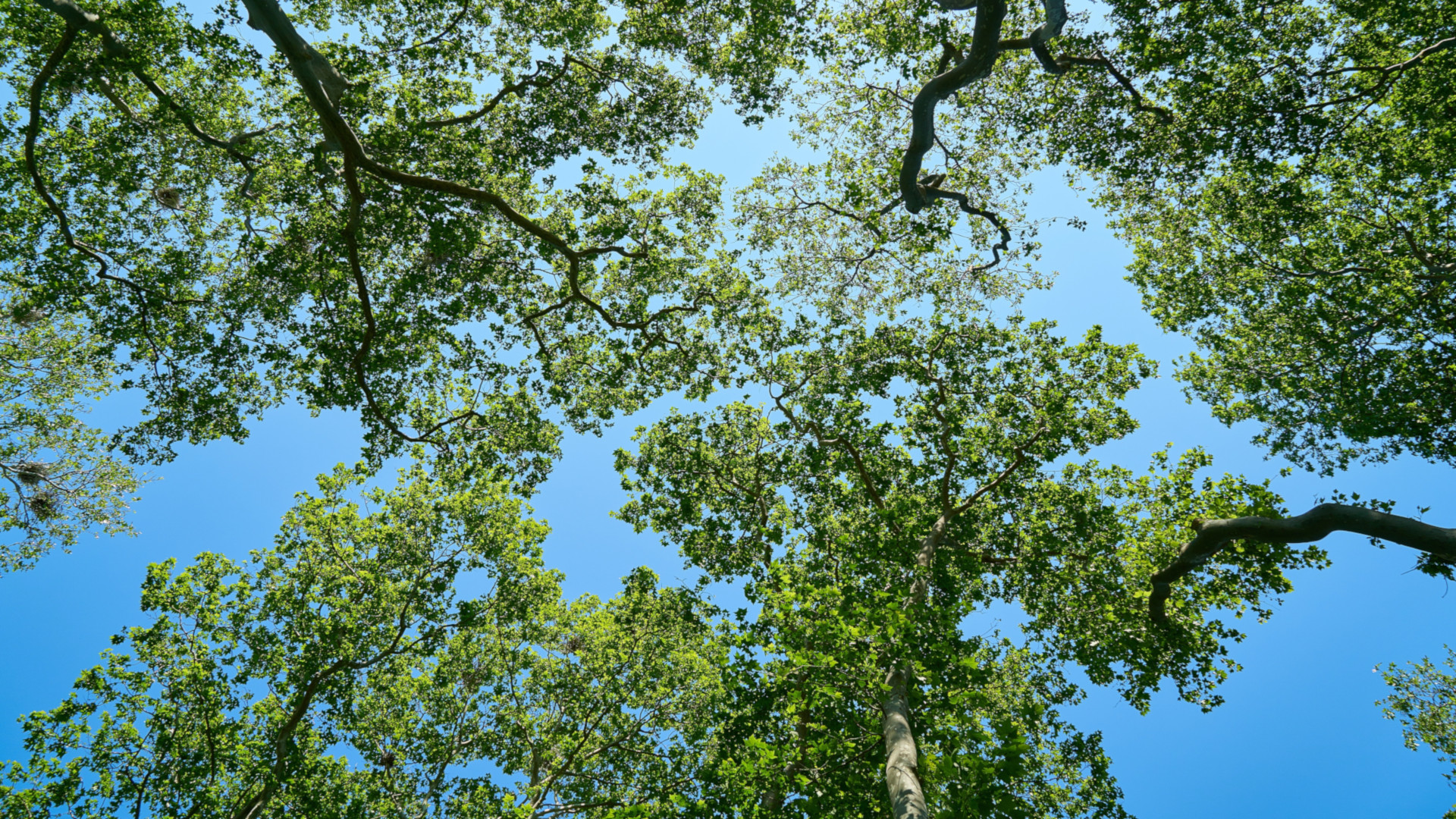
- Veterinary Experience
Our veterinary projects are perfect for aspiring vets and vet nurses, as well as those who are already qualified and wanting to experience something unique. You can either choose between specialised veterinary programmes or more generalised animal care and animal management. You’ll be working with exotic animals, as well as helping with domestic or livestock.

Volunteer With Monkeys In South Africa
- Volunteer With Animals Abroad
- Summer Trips
- Volunteer Holiday Trips
- South Africa
Join an expert team on a ‘Big 5’ reserve, situated on the edge of the beautifully wild Kruger National Park. With over 400 baboons in various stages of rehabilitation, you’ll get to learn so much about these amazing primates during your time at this bespoke centre.
Price from: £982
Price Guide
You can volunteer here throughout the year for 2-12 weeks.
Whilst late-availability is possible, we would advise booking as soon as possible to guarantee your ideal dates.
Book 2 or more projects in South Africa and save £50 per project.
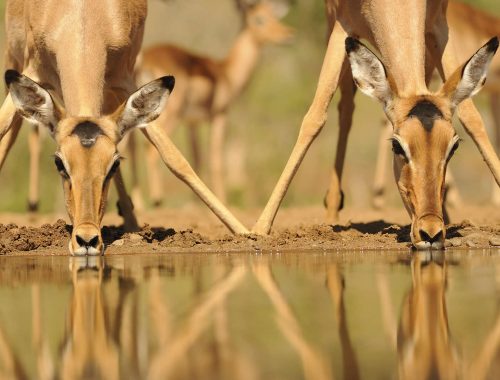
Veterinary Volunteering & Courses in South Africa
- Internships
Gain unparalleled access to wildlife experts on a Big 5 game reserve, home to some of the most magnificent mammals on this planet. Shadow a vet on their rounds of the on-site rehabilitation centre and get stuck in to the veterinarian’s role on the wider game reserve – from darting animals to doing game captures, from health checks to autopsies.
Price from: £1675
You can take part in this programme throughout the year for 2,3 or 4 weeks.
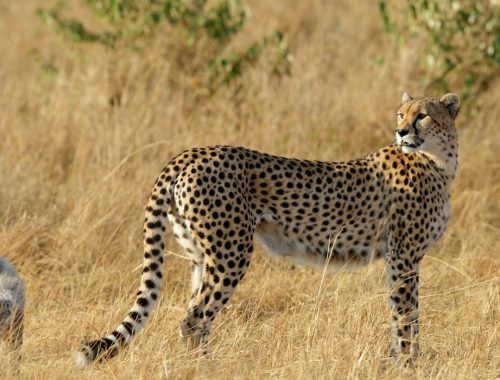
Veterinary Internship in South Africa
Help to care for sick and injured animals in game reserves, vet clinics, farms and local communities on a mobile veterinary unit. See some amazing sights, help with some incredible animals and get unrivalled work experience on this internship in South Africa.
Price from: £2299
Our 3 week advanced internship for 2nd and 3rd year students costs £3899
This year’s course runs 19th June – 10th July 2023
Hands-on veterinary work experience abroad
If you love animals and are thinking about a future career in veterinary work or animal care, our veterinary experience abroad programmes are a great option. Vet experience is essential for being able to get into university or for future job prospects, so why not join a veterinary project abroad and make an adventure out of it? For the veterinary experience project, no prior qualifications or experience are required.
Oyster also offers a more advanced internship programme in South Africa that is designed to give you a hands on experience in treating and working with a range of animals on game reserves, farms and clinics. It can be done as part of a gap year, a summer break from university and also once university is completed. Suitable for vet nurses as well as training veterinarians, giving some great veterinary work experience abroad that you could never get in your home country.
This is a fantastic way to make a genuine contribution to animal welfare, whilst improving your own veterinary knowledge and enhancing your C.V. In addition to this, you will get the chance to live and travel in some of the most exciting locations around the world. You will get to know the locals, make new friends, and obtain great practical and theoretical experience to set you up for study!
Receive our Newsletter
- Your first name *
- View our Privacy Notice to see how we store and use the data you provide.
- Phone This field is for validation purposes and should be left unchanged.

Choose a Project
- Adventure Travel
Animal Welfare and Conservation
- Environmental Conservation
- Marine conservation
- Volunteer with Elephants
- Hospitality Work
Qualifications, Courses and Credits
- Academic Credit Diploma
- Conservation Career Kick-Starter Course
- Medical Work Experience
- Ski Instructor Courses
- Ski Season Jobs

Teaching and Childcare
- Sports Coaching
- Teach English Abroad
Choose a Destination
Australasia.
- New Zealand
North America
South america, what kind of traveller are you.
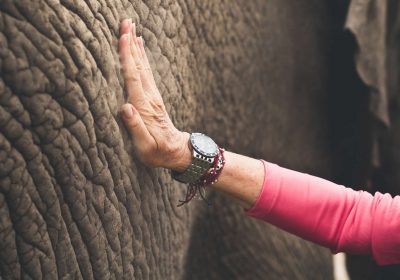
Adult Gap Year Programs

Career Break
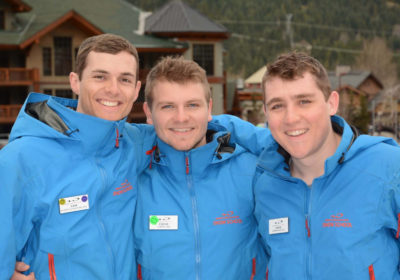
Duke of Edinburgh

Family Travel

Gap Year Programs

Group Travel
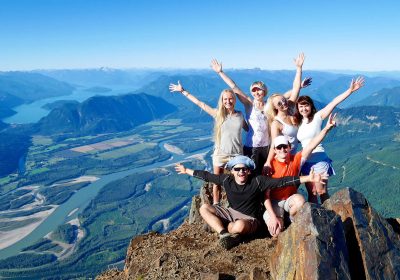
School and College Trips

Solo Travel

Welcome to Oyster
We are a highly experienced gap and responsible travel organisation that has been sending volunteers and paid workers to diverse and exciting destinations around the world since 2006.
- Meet the team
- Partners and Recognition
- School Visits
- Code of Conduct
- Our Policies
- How we choose our projects
- Why volunteer abroad?
- Year Out Group
- Work with us
Get in Touch
Our project pages are packed full of information that you may require before booking a place with us.
- Request Call back
- Request Info
Ask a question
Use our search engine to find your ideal destination or project:.
- Your name *
- Your Email Address *
- Country of residence *
- Area of interest Select one Australia - CITY: paid work and orientation tour Australia - OUTBACK: orientation and paid farm work Australia - RURAL: paid horse work and Sydney tour Austria - Austria Ski Instructor Course With Guaranteed Job Borneo - Volunteer with bears in Borneo Borneo - Wildlife conservation volunteering for families in Borneo Borneo - Wildlife conservation volunteering in Borneo Canada - 11 Week Ski & Snowboard Instructor Course in Whistler, Canada Canada - 4 Week Ski & Snowboard Instructor Course in Whistler, Canada Canada - 7 Week Ski & Snowboard Instructor Course in Whistler, Canada Canada - Banff Ski Season Jobs Canada - Banff Summer Hospitality Jobs Canada - Hospitality Jobs in Whistler With Accommodation Canada - Whistler Ski Season Jobs Canada - Whistler, Blackcomb Ski Instructor Jobs, Courses & Training China - Backpacking tour of China Costa Rica - Costa Rica Turtle Conservation & Sanctuary Volunteering Costa Rica - Costa Rica Turtle Conservation Holiday With The Family Ecuador - Wildlife sanctuary volunteering in Ecuador India - India backpacking tour Japan - 13 day backpacking tour of Japan Namibia - Elephant Conservation Volunteering In Namibia Namibia - Elephant conservation volunteering for families in Namibia Nepal - Volunteer as a teacher in Nepal Nepal - Women's empowerment volunteering in Nepal New Zealand - AUCKLAND: paid city work and orientation tour Portugal - Food waste reduction volunteering in Portugal Portugal - Marine conservation in Portugal Portugal - Volunteer with wolves in Portugal Romania - Family volunteering with Bears in Romania Romania - Medical Internship in Romania Romania - Volunteer with Bears in Romania South Africa - Big 5 wildlife conservation experience for families in South Africa South Africa - Game Ranger Training Courses in South Africa South Africa - Marine Ocean Conservation Projects in South Africa South Africa - South Africa Monkey & Family Volunteering Holiday South Africa - Sports Coaching Volunteering in South Africa South Africa - Veterinary Internship in South Africa South Africa - Veterinary Volunteering & Courses in South Africa South Africa - Volunteer With Children in South Africa South Africa - Volunteer With Monkeys In South Africa South Africa - Volunteer with Elephants in South Africa South Africa - Wildlife Conservation Volunteer Projects in South Africa Spain - Diving to fight plastic pollution in Barcelona Spain - Volunteer with rescued cats in Barcelona Sri Lanka - Elephant Conservation in Sri Lanka Sri Lanka - Elephant conservation in Sri Lanka for families Thailand - Elephant Sanctuary Volunteering In Thailand Thailand - Family volunteering in Thailand at a wildlife sanctuary Thailand - Family volunteering in Thailand at an elephant sanctuary Thailand - Gain a TESOL and teach English in Thailand Thailand - Marine Conservation in Thailand Thailand - Southeast Asia backpacking tour Thailand - Wildlife sanctuary volunteering in Thailand Vietnam - Train and teach English in Vietnam
- Your Question *
- How did you hear about us? * Select one Instagram Gapyear.com Seasonworkers.com The Big Issue Facebook Bestskijobs.com Year Out Group Family & friends Talk at school Gap fair Gap-Year.com AnyworkAnywhere Careerbreaksite.com Notgoingtouni.co.uk E4S (employment4students) Studentbeans.com GoAbroad wegweiser-freiwilligenarbeit.com Responsible Travel Oneworld365 Referred by another organisation Prospects USA Gap Fairs Information from careers service Teacher at school Net surfing Animal Jobs Direct Gooverseas Gapwork.com Natives.co.uk Advert (please enter advert reference in box below) Duke of Edinburgh guidisto-volontariat.fr Best Web Jobs Best Gap Year Ski-Jobs website TEFL-Jobs website Oyster Newsletter Govoluntouring Trekunion Seethewild Other (please specify in box below)
- Advert reference
- Specify "other" reference
- Comments This field is for validation purposes and should be left unchanged.
Request callback
- Nationality *
- Your phone (inc. International code) *
- Your E-mail address *
- Programme of interest *
- What would you like to discuss?
Privacy Overview
- Name This field is for validation purposes and should be left unchanged.

- Visit Our Blog about Russia to know more about Russian sights, history
- Check out our Russian cities and regions guides
- Follow us on Twitter and Facebook to better understand Russia
- Info about getting Russian visa , the main airports , how to rent an apartment
- Our Expert answers your questions about Russia, some tips about sending flowers

Russian regions
- Altay republic
- Irkutsk oblast
- Kemerovo oblast
- Khakassia republic
- Krasnoyarsk krai
- Novosibirsk oblast
- Omsk oblast
- Tomsk oblast
- Tuva republic
- Map of Russia
- All cities and regions
- Blog about Russia
- News from Russia
- How to get a visa
- Flights to Russia
- Russian hotels
- Renting apartments
- Russian currency
- FIFA World Cup 2018
- Submit an article
- Flowers to Russia
- Ask our Expert
Omsk city, Russia
The capital city of Omsk oblast .
Omsk - Overview
Omsk is one of the largest cities in Russia, a major scientific, cultural, sports, transport, and industrial center. The administrative center of Omsk Oblast, it is the second most populous city in Siberia.
The population of Omsk is about 1,126,000 (2022), the area - 567 sq. km.
The phone code - +7 3812, the postal codes - 644000-644246.
Omsk city flag
Omsk city coat of arms.
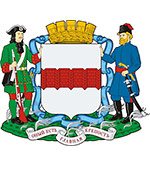
Omsk city map, Russia
Omsk city latest news and posts from our blog:.
10 November, 2019 / Tomsk - the view from above .
3 July, 2016 / Omsk - the view from above .
20 October, 2012 / The bear at the gate .
2 August, 2012 / Omsk city from bird's eye view .
14 December, 2011 / Time-lapse video of Omsk city .
More posts..
History of Omsk
Foundation of omsk.
The need to build a Russian fortress on the banks of the Irtysh at the mouth of the Om River arose in connection with the steppe nomadic peoples. In particular, with the Oirats, whose tribes in the first decades of the 17th century began to appear within the borders of the Russian state being under the onslaught of their external enemies and as a result of internal civil strife. However, various foreign and domestic political problems of Russia hindered the development and defense of the South Siberian borders.
The situation changed only at the beginning of the 18th century, when the Russian conquest of Siberia intensified. Since Peter I paid great attention to geographical research in the south, the expeditions of that time combined socio-political tasks and tasks of scientific research.
One of such expeditions was led by the Russian military and statesman, associate of Peter I, Major General Ivan Bukhgolts. The goals of the expedition, numbering about 3,000 people, were to search for ore and gold deposits, the discovery of trade routes to India and China, as well as the construction of towns on the Irtysh River.
The expedition left Tobolsk to the south along the Irtysh in July 1715. In the spring of 1716, after a conflict with the Dzungars in the north of today’s Kazakhstan, the remnants of the expedition (about 700 people) withdrew to the mouth of the Om River, where they laid a new fortress named Omsky ostrog (fortified settlement).
According to the census of 1725, 992 people lived in the fortress, in 1742 - 1,092 people. From the first years of its existence, it served as a place of exile for prisoners. After serving hard labor and imprisonment, a lot of them stayed in Omsk for permanent residence.
More Historical Facts…
Omsk in the second half of the 18th century
The ethnic composition of the region’s population was formed in the process of settling the territory. Russians, Germans, Ukrainians, Poles, Belarusians, and representatives of many other nationalities were sent here to serve or were exiled. The indigenous people of the region were the Siberian Tatars and Kazakhs, who switched to a sedentary lifestyle.
The foundation of the second Omsk fortress took place in 1762. The first fortress, although it occupied a favorable geographical position, was wooden and, by the middle of the 18th century, it was dilapidated. In 1765, new stone fortifications were constructed. The first stone structure of the fortress was the Resurrection Military Cathedral, built in 1773 and preserved to this day.
In the end of the 18th century, the Omsk fortress was one of the largest structures in the eastern part of the Russian Empire, its area was more than 30 hectares. In 1782, it was transformed into a town named Omsk within the Tobolsk Governorate. In 1785, the coat of arms of Omsk was approved.
Omsk became the center of management of the Siberian transport routes and the Siberian Cossack army, which not only guarded the South Siberian borders, but also made a huge contribution to the economic development of the steppe expanses of Kazakhstan, the annexation of Central Asia to the Russian Empire.
Omsk in the 19th century
The fire of 1819 destroyed almost half of the town including the archive and the magistrate of Omsk with all the first archival documents. Therefore information about the life of Omsk in the 18th - early 19th centuries is scarce and fragmentary. In 1825, the population of the town was about 9,000 people.
In 1829, the town’s development plan was approved. It was made by the famous Petersburg architect V.I. Geste, who took the city of St. Petersburg as a model with its wide avenues, huge neighborhoods, fountains, cast-iron bridges, and an abundance of green spaces.
The composition of the population of Omsk was not quite usual. In the middle of the 19th century, since Omsk was the center of the military and civil administration, the proportion of the military in the local population reached about 60%.
Fyodor Dostoevsky (one of the greatest psychological novelists in world literature), who served a term of hard labor in the Omsk prison in 1850-1854, in a letter to his brother gave Omsk the following description: “Omsk is a disgusting town. There are almost no trees. In summer, heat and wind with sand, in winter, a snowstorm. I have not seen nature. The town is dirty, military and highly depraved.”
By the second half of the 19th century, Omsk in its development outstripped many steppe towns and became not only an administrative, but also a commercial and industrial center. In 1861, in Omsk, there were 2,122 houses (31 stone houses), 34 factories and plants, about 20 thousand residents.
In 1892, the construction of the Trans-Siberian Railway began, which gave a new impetus to the economy of Siberian towns and positively influenced Omsk. The development of the Trans-Siberian Railway caused an increase in the urban population due to migrants who came to work from the central part of the Russian Empire. According to the 1897 census, 37.3 thousand people lived in Omsk. The town had 14 streets with a total length of more than 140 km and 13 squares.
Omsk in the first half of the 20th century
The beginning of the 20th century was a time of great changes for Siberia. Mass peasant colonization caused a sharp leap in the development of the region’s economy, primarily its agrarian sector, and the Trans-Siberian Railway ensured the inclusion of the local economy in the system of the All-Russian and European markets.
Due to its favorable economic and geographical position - at the intersection of the railway and the Irtysh River, in the middle of a vast agricultural territory - Omsk quickly turned into a large transport, trade and industrial center of Western Siberia and Governor-Generalship of the Steppes (Eastern and Central Kazakhstan).
Wholesale trade in bread, butter and other agricultural products was concentrated here. Omsk also became one of the industrial, social and cultural centers of Western Siberia. By 1903, the city’s population grew to 60 thousand people. In 1914, it had about 134.8 thousand residents. Omsk became the most populous city in Siberia.
During the Civil War on the territory of the former Russian Empire, from June 1918 to November 1919, Omsk was the residence of the Supreme Ruler of Russia, Admiral Alexander Kolchak, who declared this city the capital of white Russia opposing red Russia of the Bolsheviks. Soviet power was finally established in the city in 1920.
In the summer of 1921, an event took place that had a decisive impact on the cultural and economic life of Omsk. The functions of the administrative center of Siberia were transferred from it to the city of Novonikolaevsk (future Novosibirsk). In 1934, Omsk became the administrative center of a separate Omsk Oblast.
Over the years of industrialization, Omsk became one of the largest centers for agricultural engineering in the USSR. The metal-working industry also developed at a rapid pace. In 1939, Omsk numbered more than 288 thousand people.
During the Second World War, about 200 industrial enterprises were evacuated to Omsk, as well as 60 hospitals, dozens of educational institutions, theaters, museums, and hundreds of thousands of refugees.
Omsk after the Second World War
In the post-war years, new enterprises were put into operation in Omsk, all existing factories and plants were reconstructed and expanded. The industrial potential of the city was also strengthened by the Omsk oil refinery, the largest in the country. In connection with the rapid development of industry, especially petrochemical enterprises, the ecological situation deteriorated. The concentration of harmful substances in the air sharply increased. In 1964, the population of Omsk was about 702 thousand people.
In the 1970s-1980s, Omsk developed rapidly. In 1975, the city’s population exceeded 1 million. The most pressing problem was the ecological situation. Omsk was in the top 10 cities of Russia in terms of environmental pollution. Another problem that required an immediate solution was the development of passenger transport. The capacity of Omsk streets was exhausted, and therefore the construction of the subway became an urgent issue.
The economic crisis that gripped Russia after the collapse of the USSR had a negative impact on the economy of Omsk and the region as a whole. There was a significant decline in industrial production, construction volumes fell, and unemployment rose. A lot of organizations of the defense complex, research institutes, and design bureaus found themselves in a deep crisis without the state defense order.
The share of mechanical engineering and metalworking, light industry, and, to a lesser extent, chemical and petrochemical, forestry and woodworking industries decreased. At the same time, the share of the fuel industry, energy, and construction materials industry began to grow.
In the 2000s, Omsk again became one of the most important economic centers of Western Siberia with a developing mechanical engineering, petrochemical industry, various branches of the woodworking, construction industry, and a highly productive agro-industrial complex. In recent years, Omsk has also acquired the features of one of the largest Siberian centers of entrepreneurship and banking/financial activities.
Architecture of Omsk
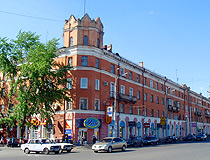
On the street in Omsk
Author: Tim Brown
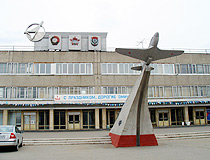
Yak-9 fighter aircraft in front of the aerospace engineering company Polyot in Omsk
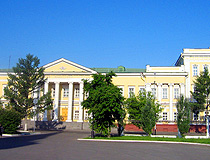
The Omsk Cadet Corps
Author: Stanislav Katsko
Omsk - Features
Omsk is located in the south of the West Siberian Plain at the confluence of the Om River into the Irtysh, about 150 km from the border of Russia with Kazakhstan. About 60% of all residents of Omsk Oblast live in Omsk. The City Day of Omsk is celebrated on the first Saturday of August.
The city’s coat of arms is very similar to the first coat of arms of Omsk approved by Empress Catherine II in 1785. It depicts a part of the brick fortifications, which symbolizes the reason for its foundation as a fortress and the center of the Siberian defensive line.
Omsk belongs to the temperate climatic zone with a continental climate of the forest-steppe of the West Siberian belt. It is distinguished by an abundance of sunlight. The average air temperature in January is minus 16.3 degrees Celsius, in July - plus 19.6 degrees Celsius. The highest wind speeds are observed in winter and spring, which is the reason for frequent snow and dust storms.
In the past, the ecological situation in Omsk was very unfavorable. Since 2011, the city’s environmental development rating has increased significantly. This was the result of large-scale modernization of many large industries (including the Omsk oil refinery). Today, road transport is the main source of air pollution in the city.
The level of pollution of the Omsk rivers - Irtysh and Om - remains consistently high. Swimming in them is prohibited. While industrial effluents are becoming more environmentally friendly, sewers are releasing waste products including diesel fuel and petroleum products into the rivers. Dust raised by dust storms is also a serious problem for the city as it contains a lot of harmful substances including lead.
The city’s industry is based on oil refining, petrochemistry, chemical industry, mechanical engineering (production of aerospace equipment, armored vehicles, agricultural equipment). Omsk is a major transport junction - the Trans-Siberian Railway runs through the city from west to east, and the navigable Irtysh River crosses it from south to north. Omsk Airport offers regular flights to Moscow, St. Petersburg, Novosibirsk, Tyumen, Surgut, Yekaterinburg, Krasnoyarsk, Salekhard, Kazan, Krasnodar, Sochi.
The unfinished subway of Omsk has become famous in Russia thanks to its only one fully built station. Its construction began back in 1992. However, due to funding problems, the completion of the first line was postponed numerous times. In 2019, it was finally decided to permanently stop construction. For local residents, because of the long wait for the completion of the construction, the Omsk metro symbolizes unrealizable hopes, they talk about it with irony.
In Omsk, there are practically no buildings higher than 50 meters, according to this parameter it is one of the lowest cities with a population of over one million. 130 architectural monuments are concentrated in the central part of the city, almost half of the total number.
Main Attractions of Omsk
Dormition Cathedral - the largest church in Omsk located in the very center of the city. The original church was built in 1891-1898. In 1935, it was completely destroyed. In 2005-2007, an exact copy of the building was restored in its original place. This is one of the most beautiful buildings in Omsk. At night, the building is illuminated and looks especially majestic. Tarskaya Street, 7.
Irtysh Embankment - the main walking street of Omsk with a picturesque view of the Irtysh River. Built in the middle of the 20th century, the embankment was reconstructed in the 2000s. You can walk along the alley on foot, ride rollerblades or a bike.
Merchant Batyushkin’s Mansion (1902). This architectural monument is located on the Irtysh Embankment. It is also known as the Kolchak’s House because Alexander Kolchak, the Supreme Ruler of Russia, lived in this building in 1919. One part of the building is occupied by the registry office of the Central District of Omsk. The Center for the Study of the History of the Russian Civil War is also open here. Irtyshskaya Naberezhnaya Street, 9.
Omsk State Museum of History and Local Lore - one of the oldest museums in Siberia and Russia founded in 1878. In total, this museum has over 200 thousand various objects of cultural, historical and artistic value. The museum is especially proud of such exhibits as the cast-iron figures of the Chinese lions Shi-Tzu, presented to the museum from China in 1895, as well as the skeleton of a woolly mammoth almost 3 meters high. Lenina Street, 23?.
Omsk Regional Museum of Fine Arts named after M.A. Vrubel - one of the largest museums of fine arts in Siberia. It has collections of foreign and Russian art from antiquity to the present day. In total, there are over 22 thousand works by painters, graphic artists and sculptors, as well as more than 1.5 thousand rare folios.
Walking through the exhibition halls, you can admire the canvases of Shishkin, Aivazovsky, Surikov, Repin, Serov, Vereshchagin. The exhibition of rare icons dating from the 17th-20th centuries is of constant interest among visitors, as well as a unique collection of jewelry made of precious metals found in the Scythian and Sarmatian burial mounds. Two buildings of the museum are located at Lenina Street 3 and 23.
In November 2019, a new exhibition was opened in a historical building at Muzeynaya Street, 4 - the exhibition of art of the 20th-21st centuries. The Hermitage-Siberia Center is located here too - the first representation of The State Hermitage Museum (the second-largest art museum in the world) beyond the Urals.
Chokana Valikhanova Street - a pedestrian street located in the historic part of Omsk. The street is decorated with abstract architectural forms, flower beds, wrought-iron lanterns. The walking area ends with an observation deck with a picturesque view of the Irtysh River.
Museum of Kondraty Belov . The museum of this landscape painter born in Omsk can be found in a picturesque wooden house, which is considered one of the most interesting architectural monuments of Omsk. The exposition tells about the life and work of Kondraty Belov, as well as about the history of the building itself.
In total, this museum has about 700 exhibits. The permanent exhibition also includes works by Kondraty Belov’s son Stanislav and paintings by some other local artists. In addition, temporary exhibitions of contemporary Omsk artists are regularly held here. Chokana Valikhanova Street, 10.
Plumber Stepanych Monument - an unusual sculpture located in the center of Omsk, which you can literally stumble upon while walking along Lenin Street between the houses #12 and #14. Leaning out of the hatch, the plumber is depicted as realistic and life-size as possible. It is among the most photographed monuments in Omsk. There is a similar sculpture in Bratislava, the capital of Slovakia.
Lyuba Monument . This sculpture, located on the opposite side of Lenin Street from the monument to the plumber Stepanych, is especially loved by Omsk residents and tourists, who love to be photographed against its background.
This beauty in a lace dress with a neckline and a crinoline sitting on an openwork bench and reading a novel had a real prototype - Lyubov (diminutively Lyuba or Lyubasha) Gasford, the wife of the Governor-General of Siberia, who lived in Omsk in the 19th century and died at a young age due to illness. One of the streets of Omsk and the park are named in her memory. She is a local symbol of femininity and beauty.
Omsk Fire Tower - a picturesque architectural monument built at the beginning of the 20th century. Inside the tower there are museum expositions dedicated to the local fire brigade and the history of tower construction. Internatsionalnaya Street, 41?.
Park of Culture and Rest named after the 30th anniversary of the Komsomol - a popular place for walks, recreation and entertainment of Omsk residents and tourists, which has retained “the spirit of the Soviet era” in its name. Today, on an area of 73 hectares, several zones have been organized, various types of recreation are presented. There are walking alleys, ponds, water activities, for example, riding on hydro-scooters.
The ice town is open in winter, the Return of the Dinosaurs exhibition - in summer. The “House Upside Down” exposition is also popular with tourists. This park is a place for mass festivities, city celebrations and events. Maslenitsa, Christmas, City Day, and other holidays are celebrated here. Maslennikova Street, 136.
Natural Park “Bird Harbor” - a specially protected area located on the path of bird migration in the central part of Omsk. During autumn flights, up to 3 thousand birds stop here for rest. It is a great place to enjoy nature, walk along the eco-trail, and observe the life of birds. The park is situated in the floodplain on the left bank of the Irtysh River next to the Victory Park on Yeniseyskaya Street.
Omsk city of Russia photos
Pictures of omsk.
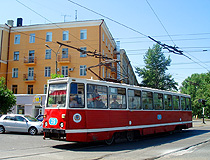
Bogdan Khmelnitsky Monument in Omsk
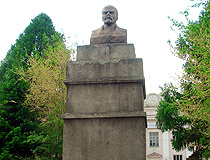
Lenin Monument in Omsk
Churches of Omsk
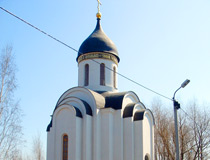
Chapel of St. George in Omsk
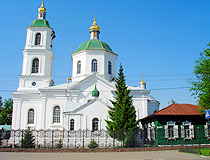
Cathedral of the Exaltation of the Holy Cross in Omsk
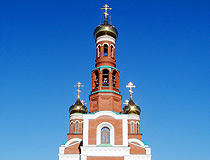
Cathedral of the Nativity in Omsk
Sights of Omsk
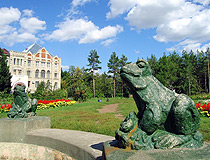
Fountain with frogs in the park next to the main building of the Agricultural Academy in Omsk
Author: Alexey Pavlov
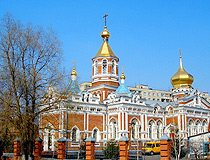
Church of St. Nicholas in Omsk
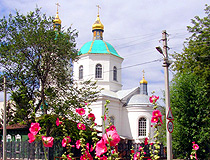
Exaltation of the Holy Cross Cathedral in Omsk
Author: Stanislav Vosinsky
The questions of our visitors
- Currently 2.96/5
Rating: 3.0 /5 (215 votes cast)
- Bahasa Indonesia
- Slovenščina
- Science & Tech
- Russian Kitchen
Omsk: Garrison city on the Irtysh
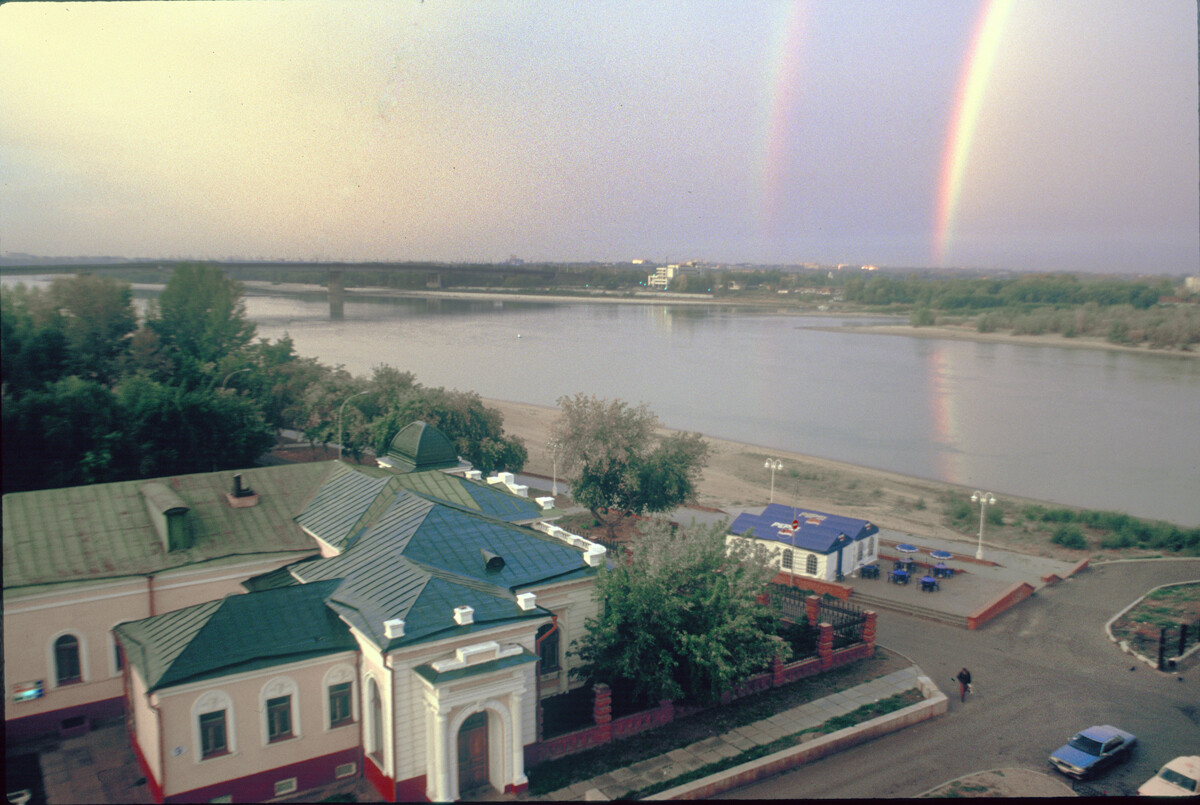
Omsk. Irtysh River, morning panorama with rainbow. Foreground: K. A. Batiushkin mansion (residence of Admiral Alexander Kolchak in 1919). September 19, 1999
At the beginning of the 20th century, Russian chemist and photographer Sergey Prokudin-Gorsky developed a complex process for vivid color photography. His vision of photography as a form of education and enlightenment was demonstrated with special clarity through his images of architectural monuments in the historic sites throughout the Russian heartland.
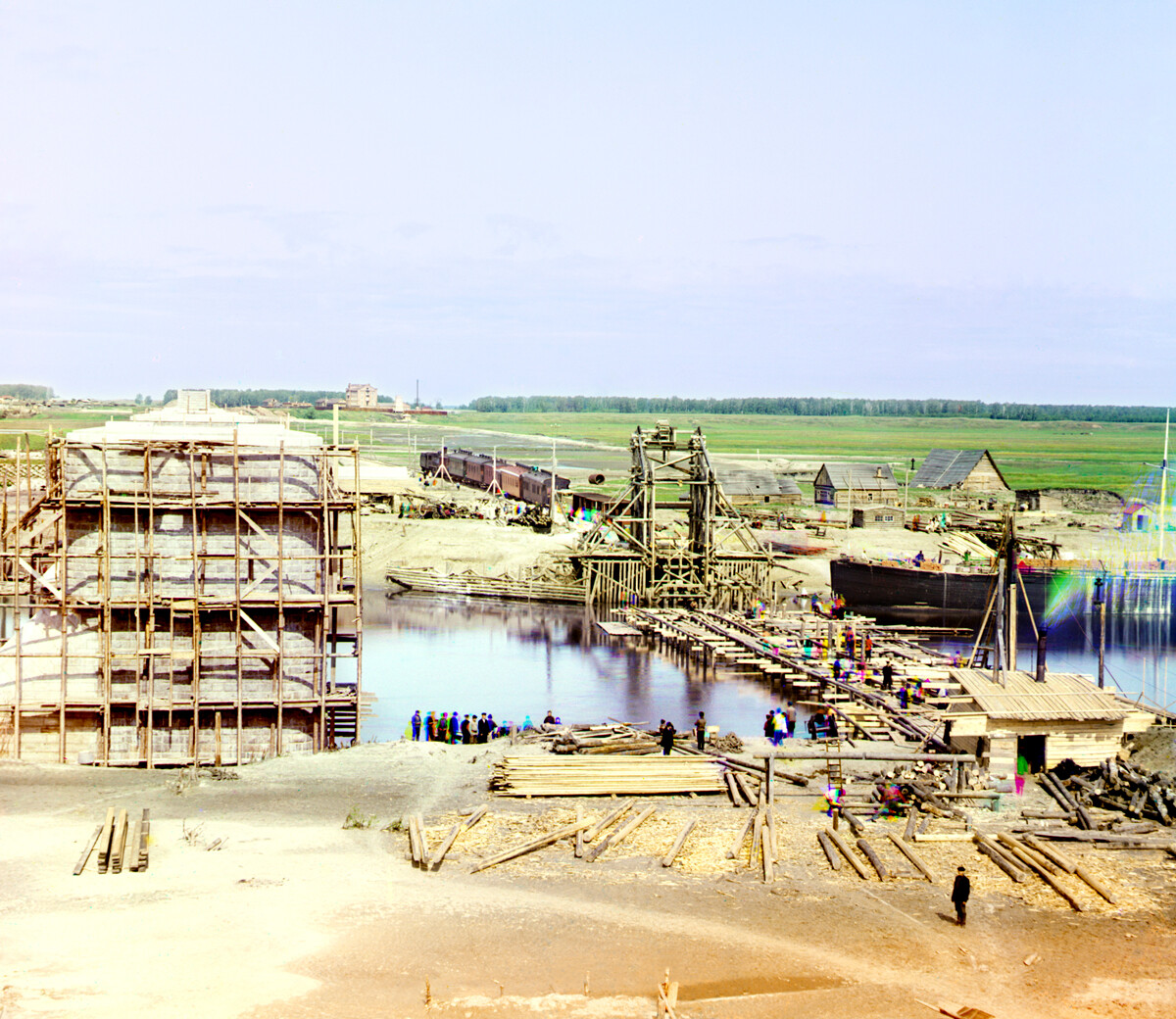
Yalutorovsk. Construction of Tobol River railroad bridge leading to Omsk. Summer 1912
In June 1912, Prokudin-Gorsky ventured into western Siberia as part of a commission to document the Kama-Tobolsk Waterway, a link between the European and Asian sides of the Ural Mountains. The town of Tyumen served as his launching point for productive journeys that included Shchadrinsk (established in 1662 on the Iset River) and Yalutorovsk (on the Tobol River).
Omsk origins
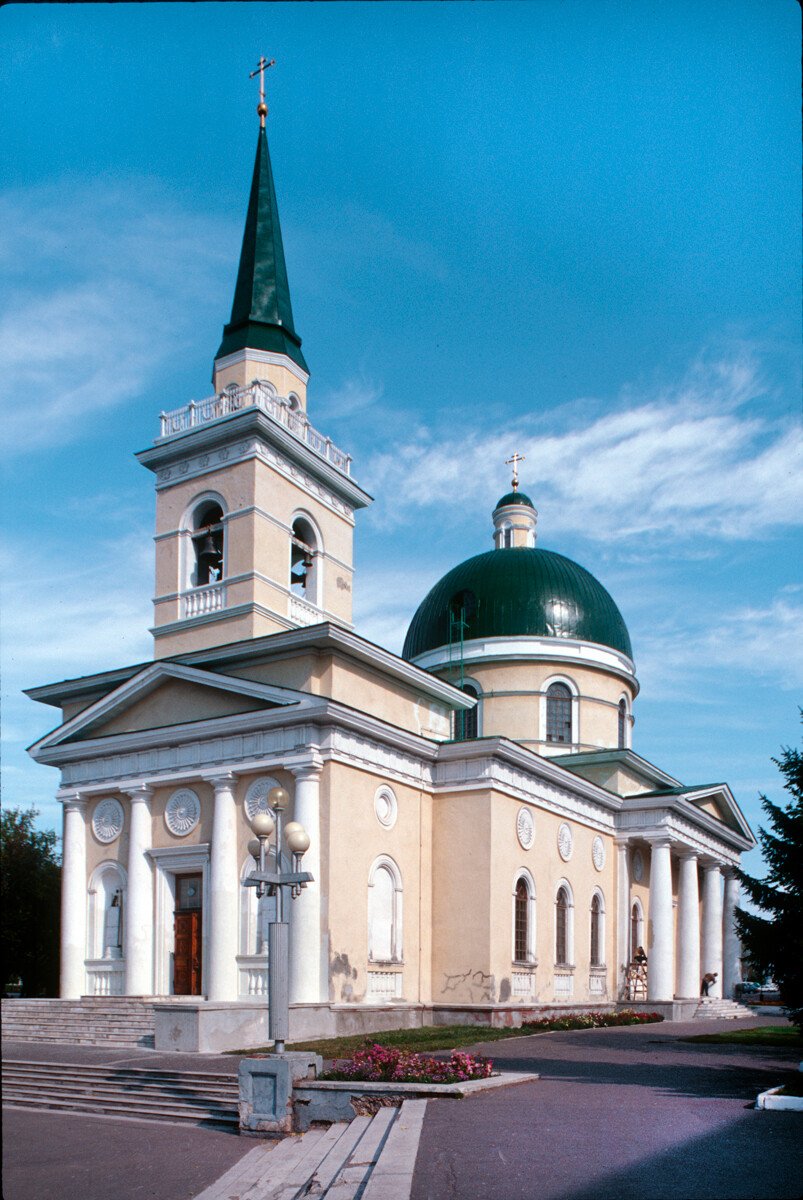
Omsk. Cossack Cathedral of St. Nicholas, southwest view. September 15, 1999
Founded in 1659 at a former Tatar settlement, Yalutorovsk was the construction site of a massive railroad bridge across the Tobol River, part of the new Tyumen-Omsk rail link that opened on the Trans-Siberian Railway in October 1913 (Before then, the railroad to Siberia went through the southern Urals town of Chelyabinsk ).
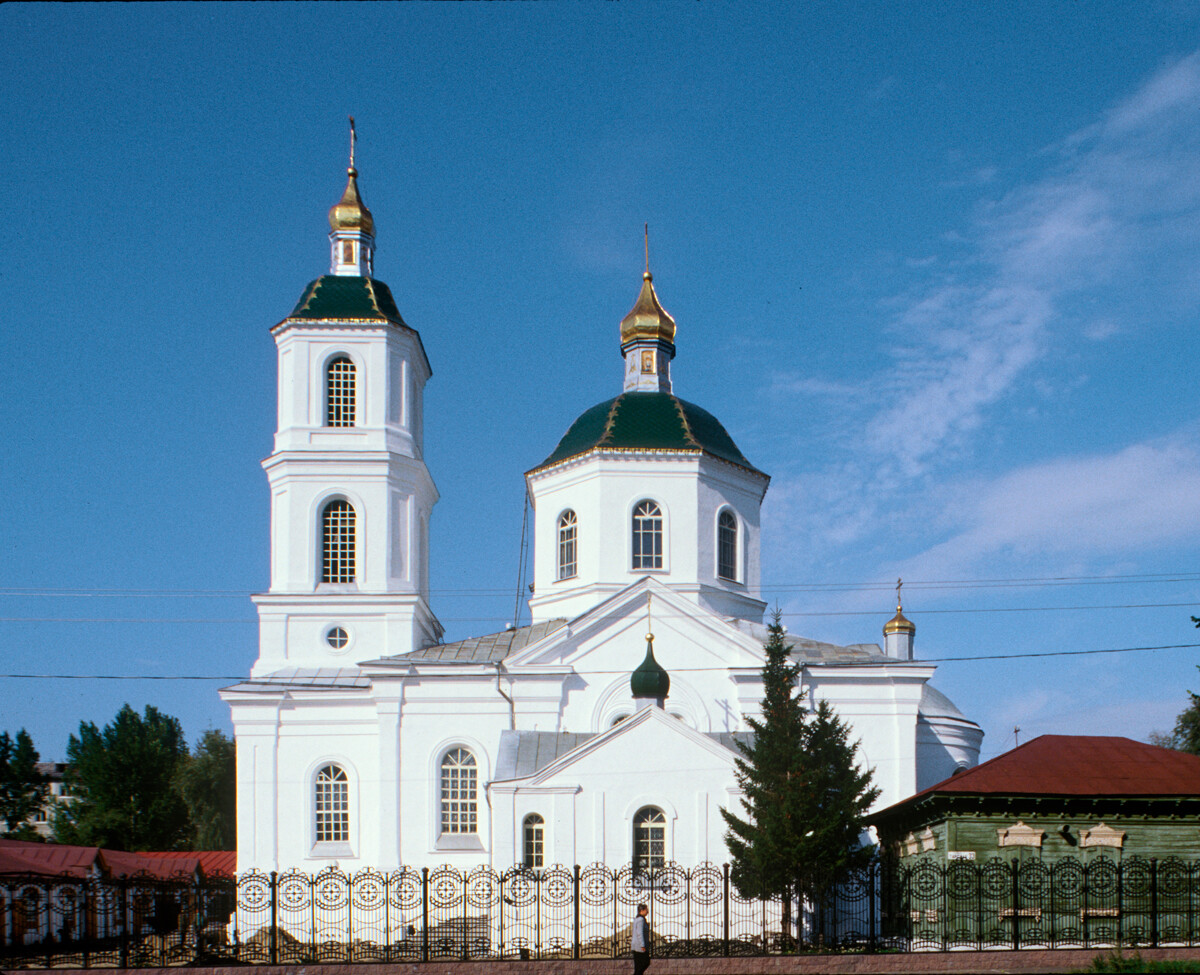
Omsk. Cathedral of the Elevation of the Cross, south view. September 15, 1999
Although Prokudin-Gorsky did not travel to Omsk, his photographs of Yalutorovsk show the making of a crucial rail link to the “capital” of western Siberia. I, however, reached Omsk in the late Summer of 1999.
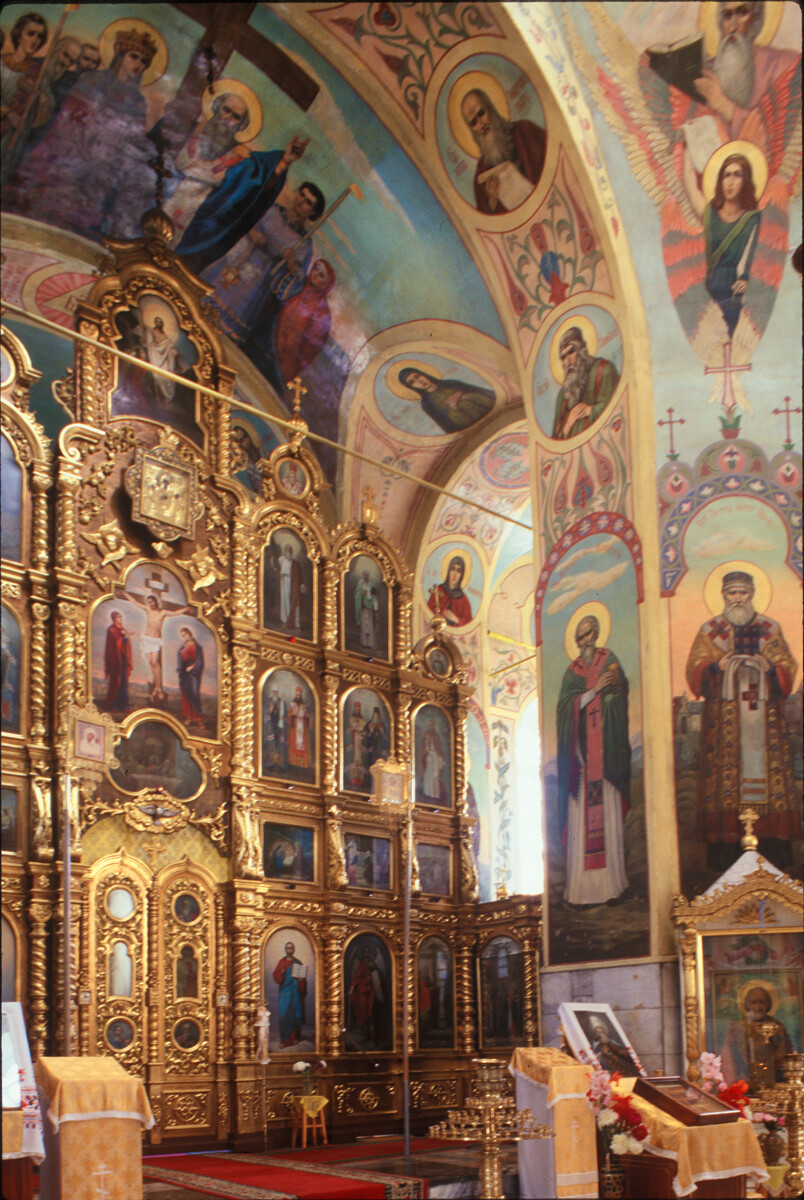
Cathedral of the Elevation of the Cross. Interior view southeast toward icon screen. September 15, 1999
Omsk (current population around 1,110,000) was founded in 1716 as a fort on the middle reaches of the Irtysh River. During the 18th century, its primary purpose was to protect Russia’s southern border and establish authority over the aboriginal steppe tribes.
Rising regional importance
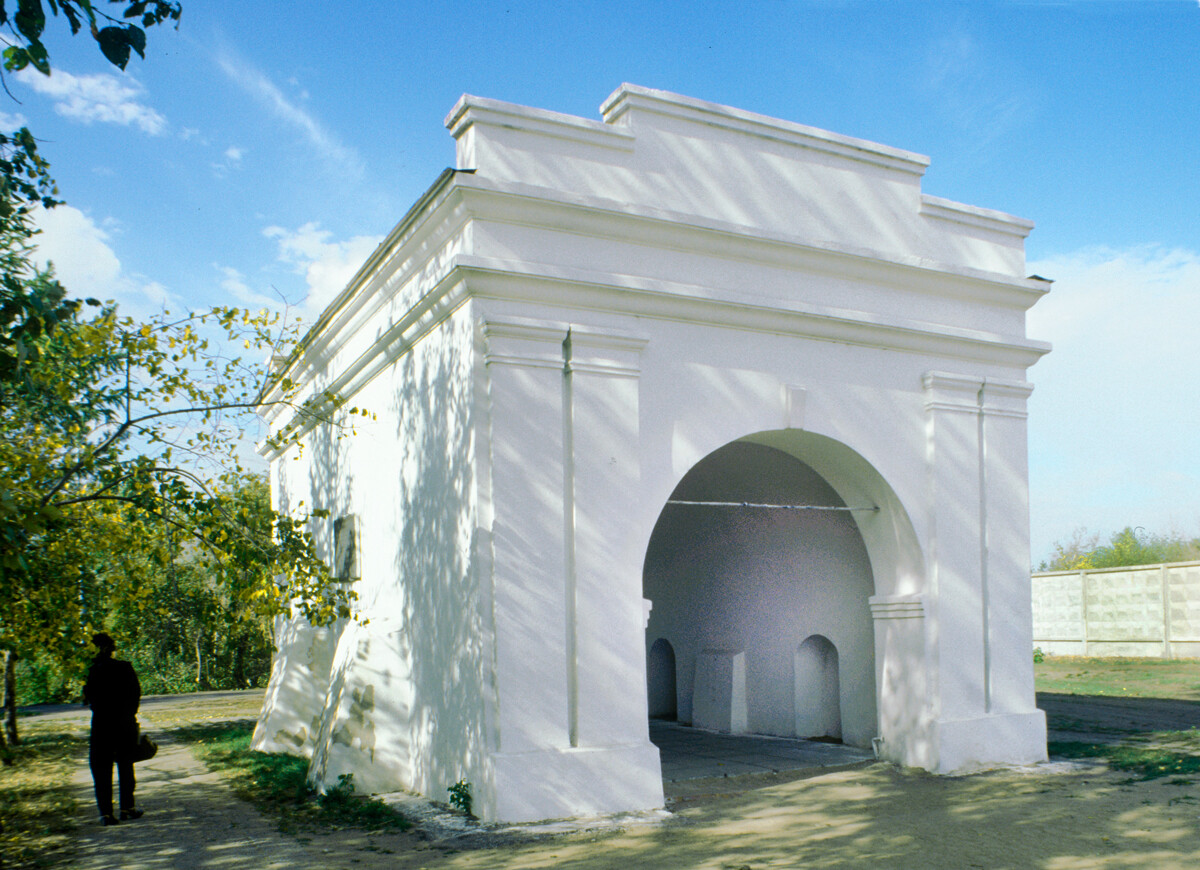
Omsk Fortress. Tobolsk Gate (originally built in 1792), the only one of the historic Omsk fortress gates to have survived. September 15, 1999
Although administratively subordinate to Tobolsk throughout the 18th century, Omsk gained increasing power in the 19th century. From 1808 until 1917, Omsk served as the headquarters of all Siberian Cossack troops and, in 1822, a separate Omsk Province was formed.
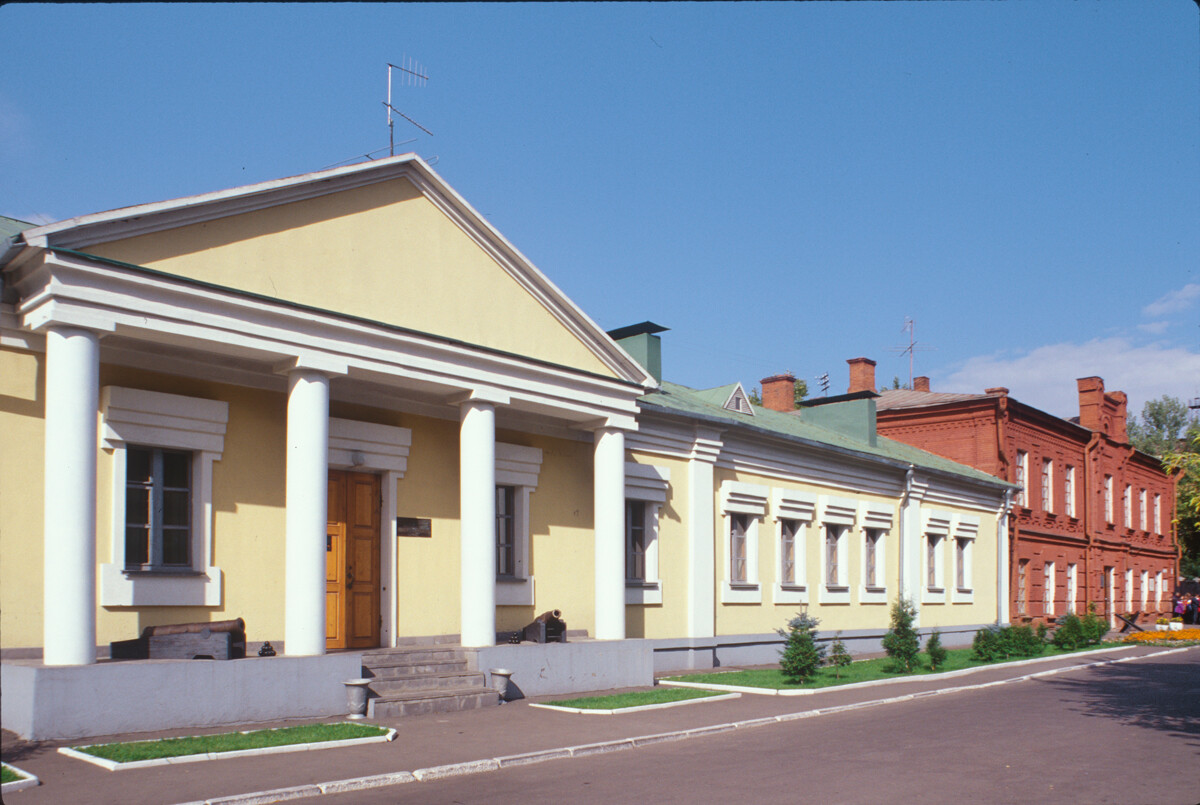
Headquarters of Omsk Fortress (Taube Street), originally built in 1810s, modified in 1997. Red brick building on right (1915-17): Staff of Omsk Military District. September 15, 1999
Shortly thereafter, construction began on the Cossack Cathedral of St. Nicholas (1833-1840), based on a plan by the noted Russian architect Vasily Stasov. The St. Nicholas Cathedral was severely disfigured during the Soviet period, but has now been restored. It is, once again, the repository of one of the area’s great relics, the banner of Yermak , the late 16th-century Cossack leader who first established Muscovy’s presence in Siberia.
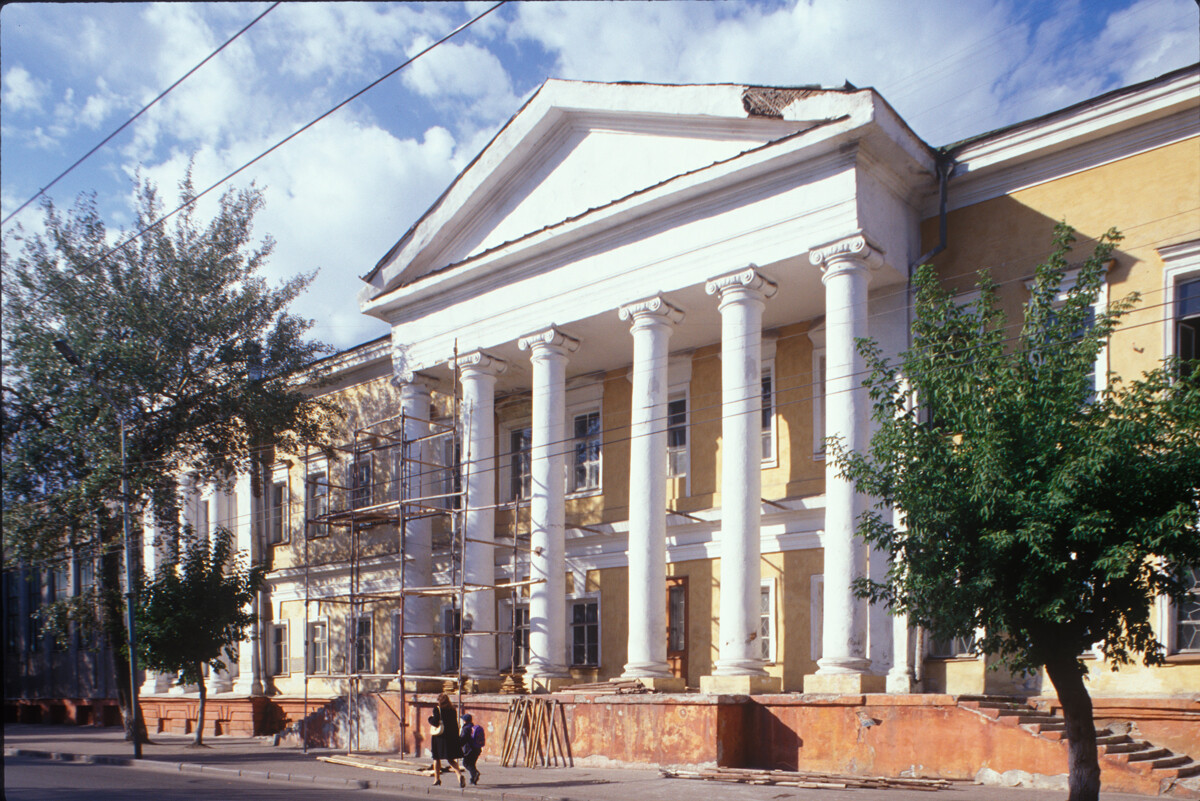
Siberian Cadet Corps building (Lenin Street 26), built in 1820s. In the prerevolutionary period, the street was known as Chernavin Prospekt, after a popular progressive mayor. September 15, 1999
In 1865-1870, Omsk witnessed the construction of another cathedral, dedicated to the Elevation of the Cross. It, too, survived the devastation of the 1930s and was reopened for worship in November 1943. In addition to its Orthodox churches, Omsk has mosques (the administration of the Iman of Siberia is located in Omsk), a remarkable wooden synagogue and a large Baptist church built in 1907.
Omsk’s dark history

Residence of Governor-General of Western Siberia (Lenin Street 23), built in 1859-62 by Friedrich Wagner for Governor Gustav Gasford. Now one of the three buildings of Omsk Museum of Art. September 18, 1999
Its pervasive military presence linked Omsk with the Siberian exile system. The most famous of the fortress’ exiles was the writer Fyodor Dostoevsky, condemned in 1849 for associating with intellectual “radicals” in St. Petersburg. In January 1850, Dostoevsky arrived under guard at the Omsk fort and, for the most part of three years (1850-54), he lived the harrowing existence of a convict sentenced to hard labor, which included unloading barges on the Irtysh River.
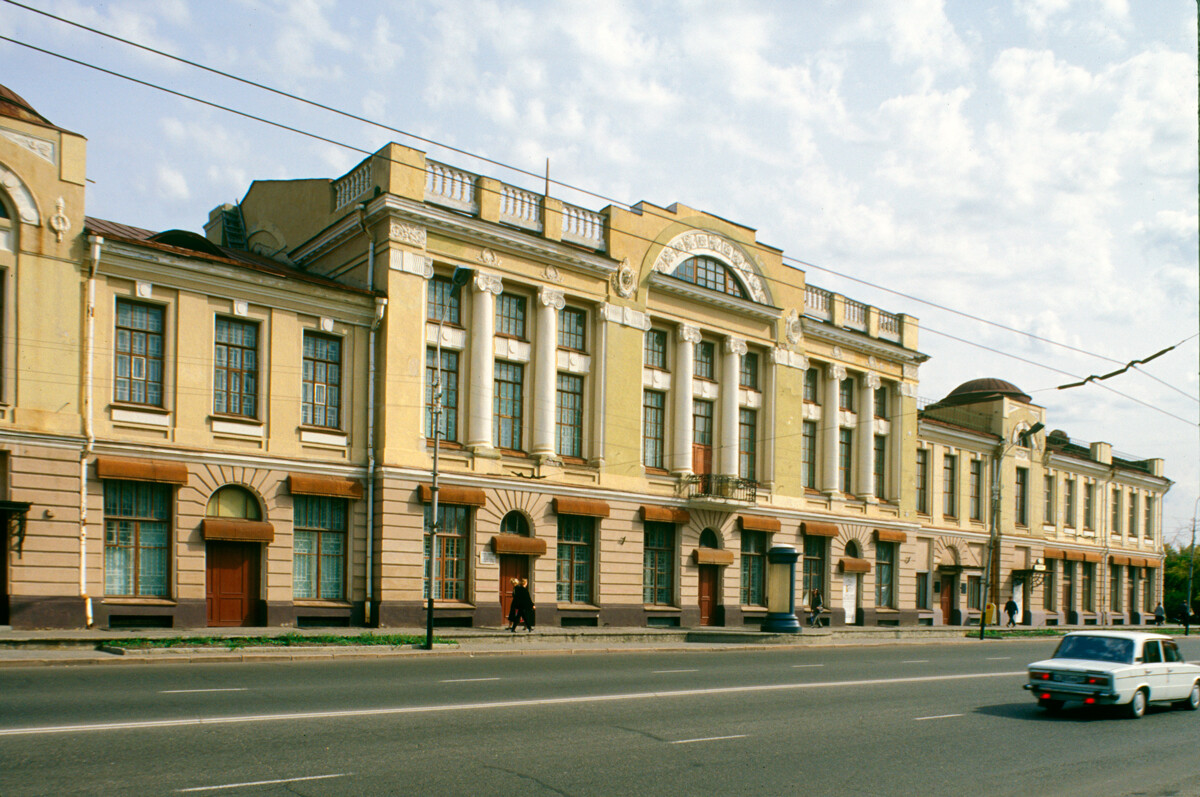
City Trade Building (Lenin Street 3), built in 1914 by Andrei Kriachkov. Now the main building of Omsk Museum of Art. September 16, 1999
When his health broke down under the physical and psychological strain, Dostoevsky was hospitalized under the care of a sympathetic medic. It was during his stay in the infirmary that Dostoevsky began the writing of one of his seminal works, ‘Notes from the House of the Dead’. A few buildings still survive from that time, including one of the fortress gates.
Railroad revolution
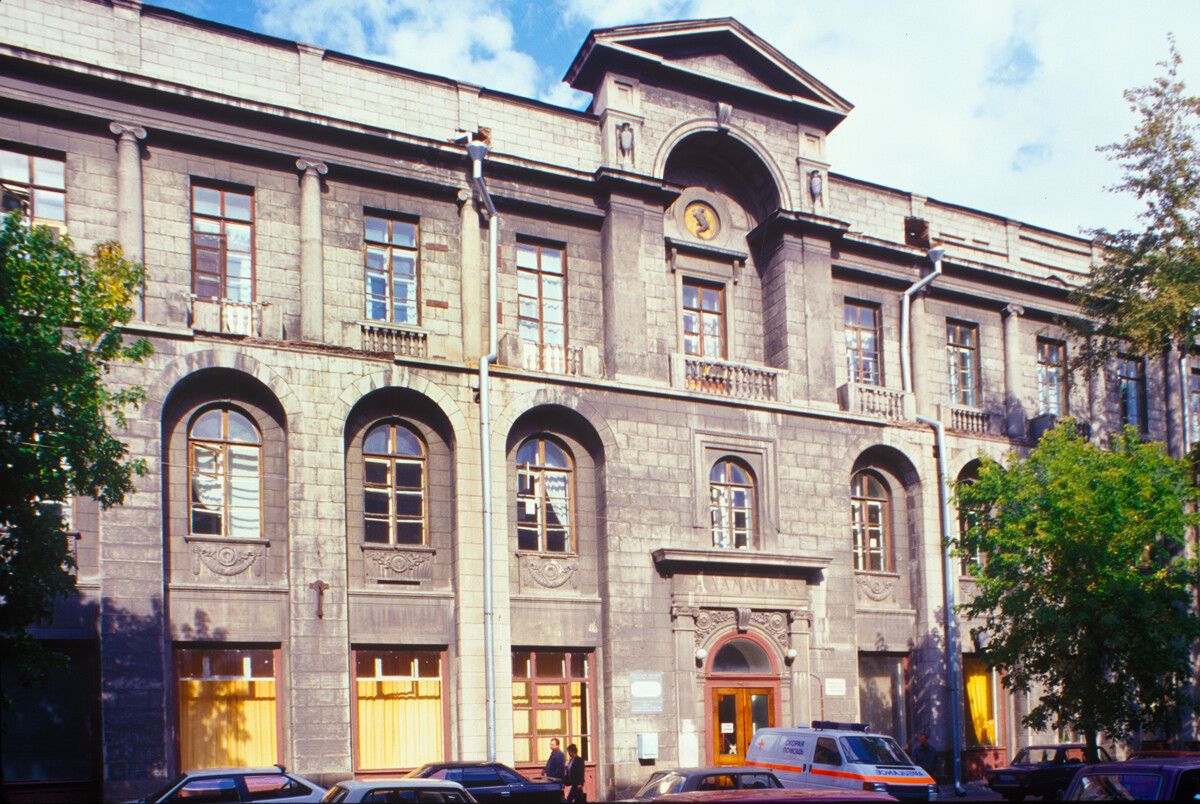
"Salamander" Insurance Company building, K. Liebknecht (formerly Gasford) Street 3, built by Nikolai Verevkin in 1913-14. Now one of the three buildings of Omsk Museum of Art. September 15, 1999
During the latter part of the 19th century, Omsk began a period of heady expansion, as the town became a transportation center for Russia’s vast interior. Regular steamboat service along the Irtysh River to Tobolsk began in 1862.
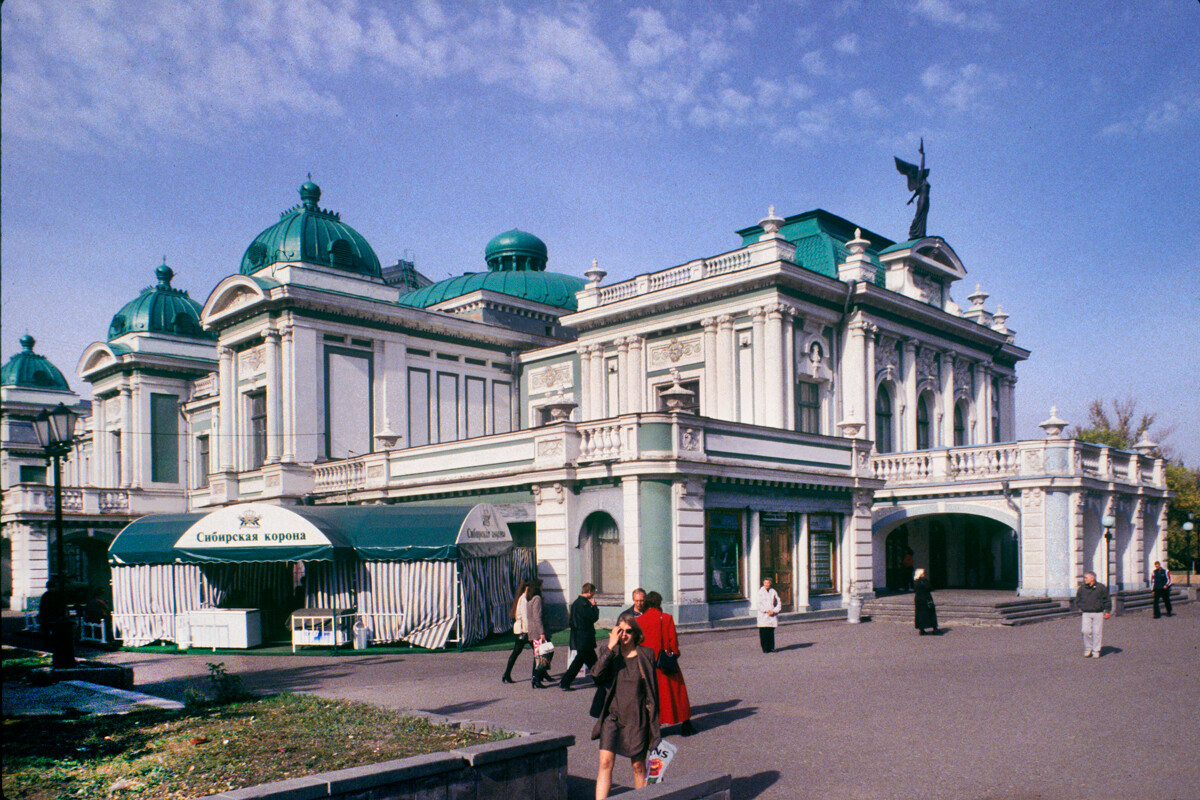
Omsk Drama Theater, Lenin Street 8A. September 15, 1999
But, it was the railroads that made Omsk a boomtown. In 1894-1895, Omsk was linked by the Trans-Siberian Railroad to Chelyabinsk in the west and Novonikolaevsk (later Novosibirsk) in the east. In 1913, another rail line was completed from Omsk to Tyumen in what would become the new Siberian mainline. By the beginning of the 20th century, the population of Omsk had tripled to over 60,000 inhabitants.
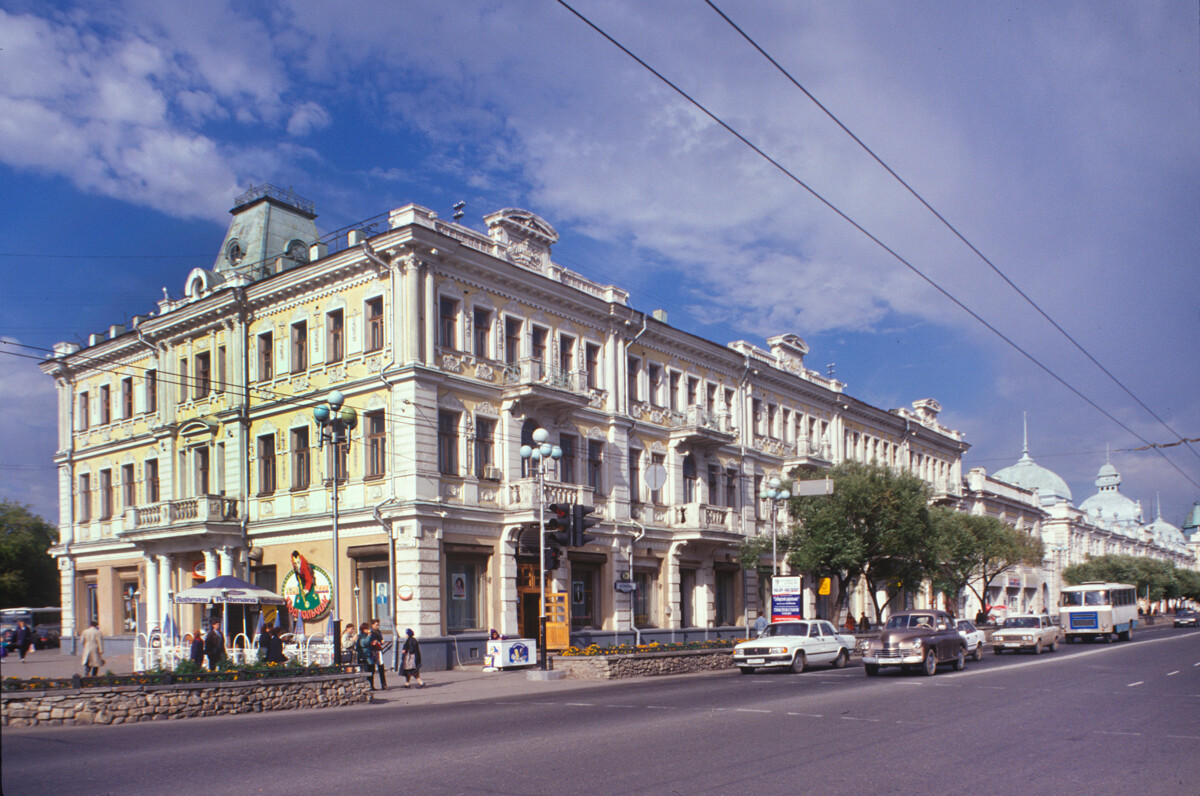
"Rossiya" Hotel (Lenin Street 18). Built by Iliodor Khvorinov in 1905-07; expanded in 1915. September 15, 1999
This development as a transportation nexus led to a surge in the city’s commercial district. What had formerly been a provincial garrison town consisting primarily of wooden structures punctuated with large churches, now became a preeminent site for banks, educational institutions, industry and retail trade in Siberia.
International appeal
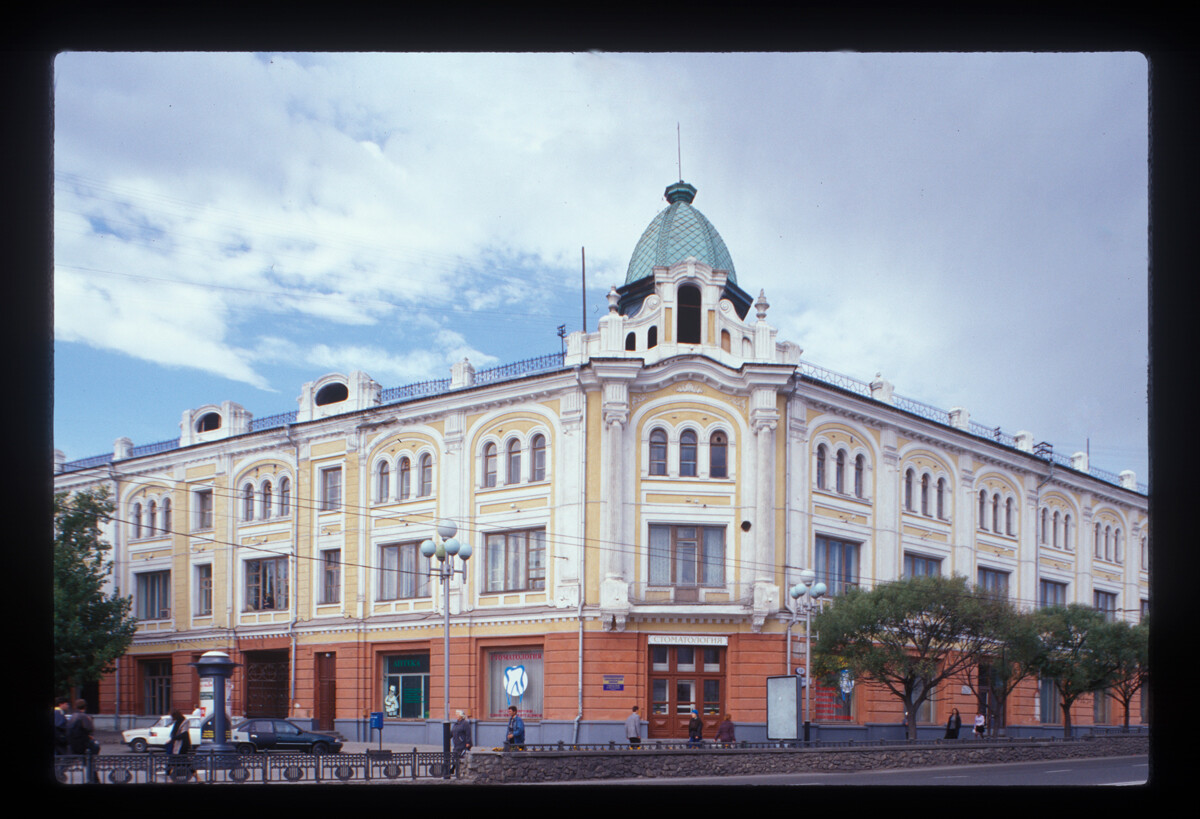
Brothers Ovsiannikov-Ganshin & Sons building (Lenin Street 12), originally completed in 1906 for a major textile company. Now the Omsk Medical Academy. September 15, 1999
In addition to branch offices for major banks and firms in Moscow and St. Petersburg, Omsk received investment from companies in the United States, Germany and Great Britain. The central part of Omsk had buildings whose design rivaled Moscow’s business district. Many of the new commercial projects were built in styles derived from the Florentine Renaissance.
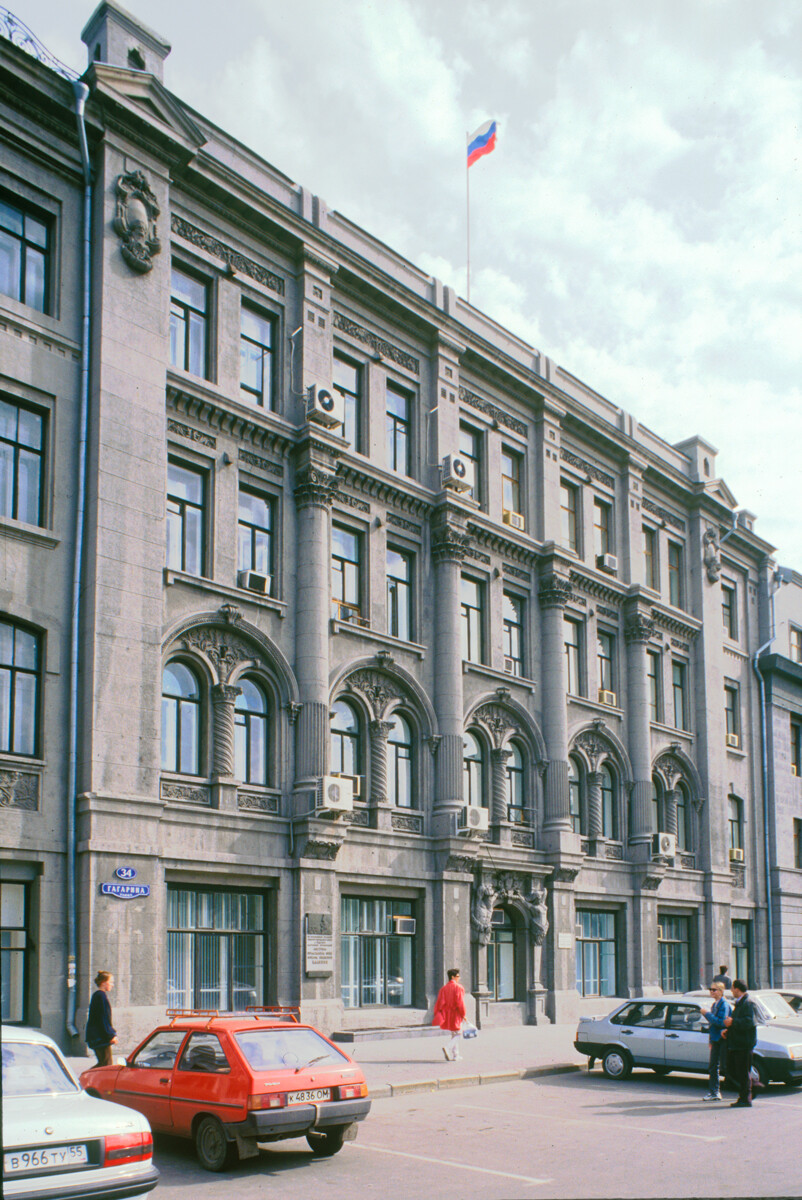
Russo-Asiatic Bank (Gagarin Street 34), built in 1915-17 by Fyodor Chernomorchenko. Now Omsk City Hall. September 16, 1999
Cultural institutions also took root. In 1901-05, a large theater was built in a florid Beaux Arts style designed by the architect Iliodor Khvorinov. The theater still stands as an object of civic pride. Wooden houses with decorative detailing also grace the city, but their number has steadily decreased under the pressures of urban development and inadequate maintenance.
Soviet era…
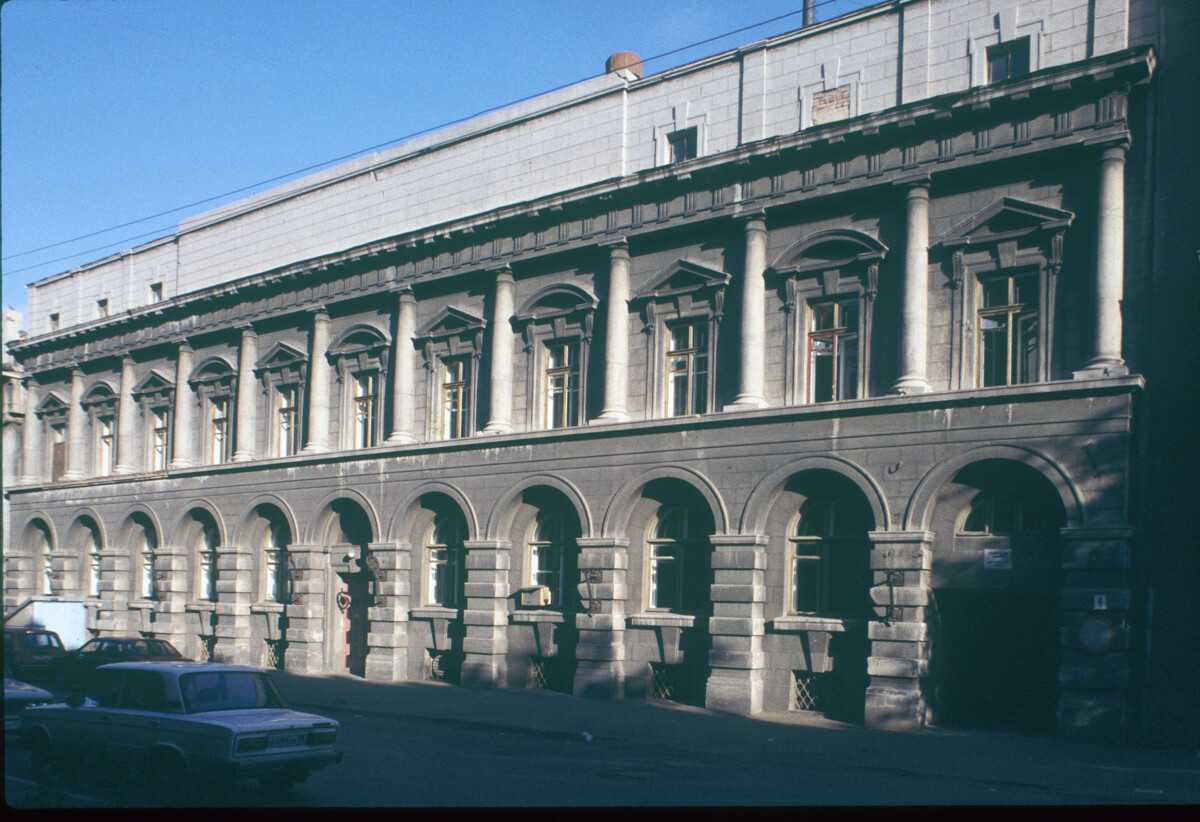
"Treugolnik" (Russian-American Rubber Co.) Building, K. Liebknecht (formerly Gasford) Street 4, built by Nikolai Verevkin in 1914-15. September 15, 1999
During World War I, the then strategically located Omsk grew still further and, by 1917, the city’s population had reached 100,000. Following the October Revolution, Bolshevik power was proclaimed almost immediately in Omsk, but, with little local support, the Bolsheviks were driven from the city in June 1918.
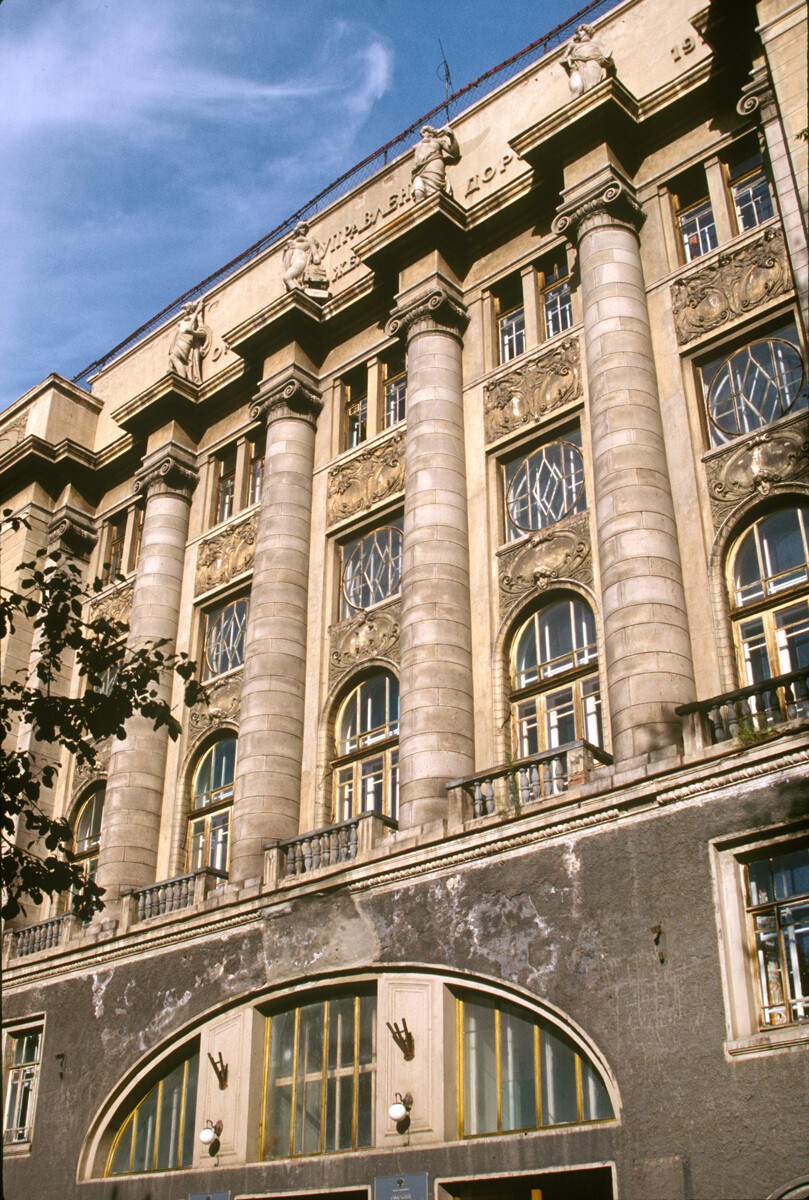
Omsk Railroad Administration (Karl Marx Street 35), de factor headquarters of western Trans-Siberian Railway. Built in 1914-16 by Fyodor Lidval. September 18, 1999
Opposition to the Bolsheviks was fatally divided and, in November 1918, a military coup installed a dictatorship headed by Admiral Alexander Kolchak (1874-1920), a renowned polar explorer and gifted naval commander, but incapable of dealing with the chaos of the Russian civil war (The mansion where Kolchak had his headquarters is a prominent landmark).
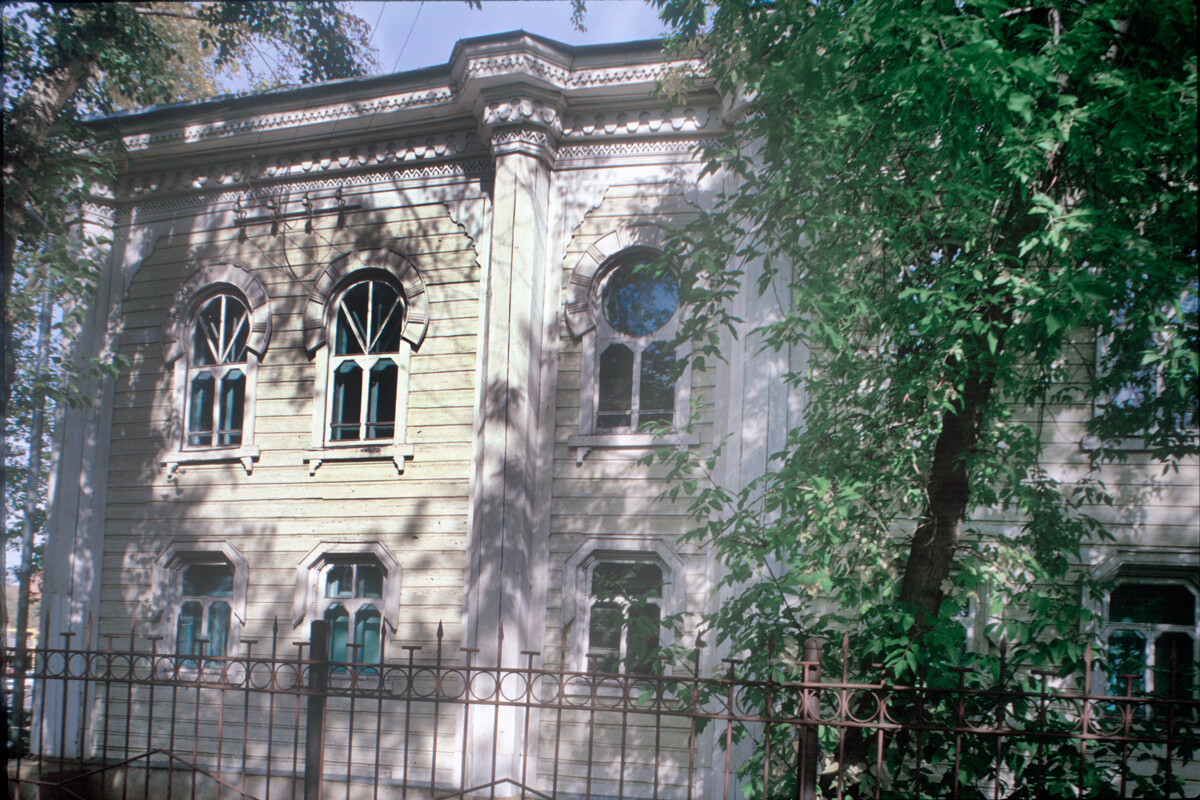
Omsk Synagogue (Marshal Zhukov Street 53). Known as "Soldiers Synagogue," built in 1855. September 18, 1999
For almost a year, Omsk could be considered the “capital” of the White forces in the Russian Civil War. In November 1919, Kolchak’s forces were driven from Omsk. In 1921, Omsk became one of the centers of the American Relief Agency during the terrible famine that afflicted vast territories in the Volga basin.
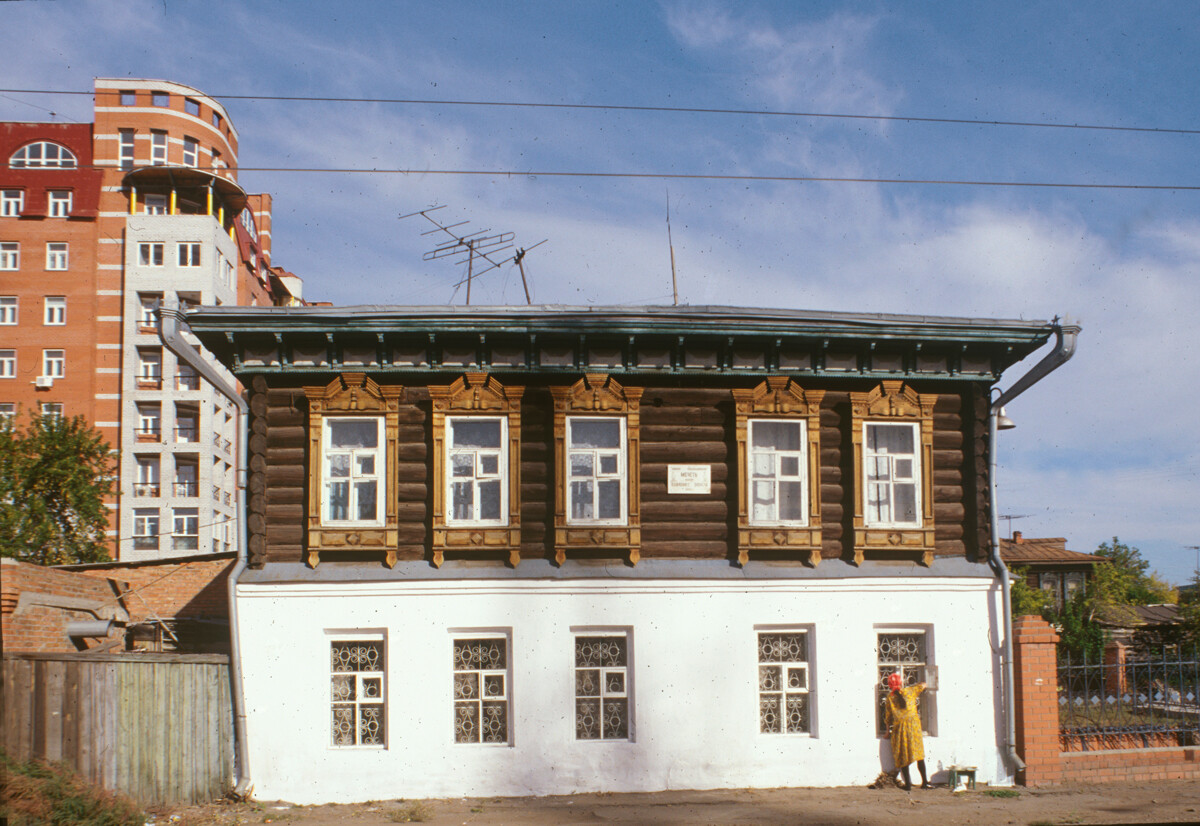
Hodja Akhmed Mosque (Marshal Zhukov Street 97). September 18, 1999
With its economy shattered and the countryside still recovering, Omsk struggled through the 1920s and achieved renewed industrial growth in the 1930s. Like many Siberian cities, it expanded rapidly during World War II as an evacuation haven and as a center of transportation and production.
…and beyond
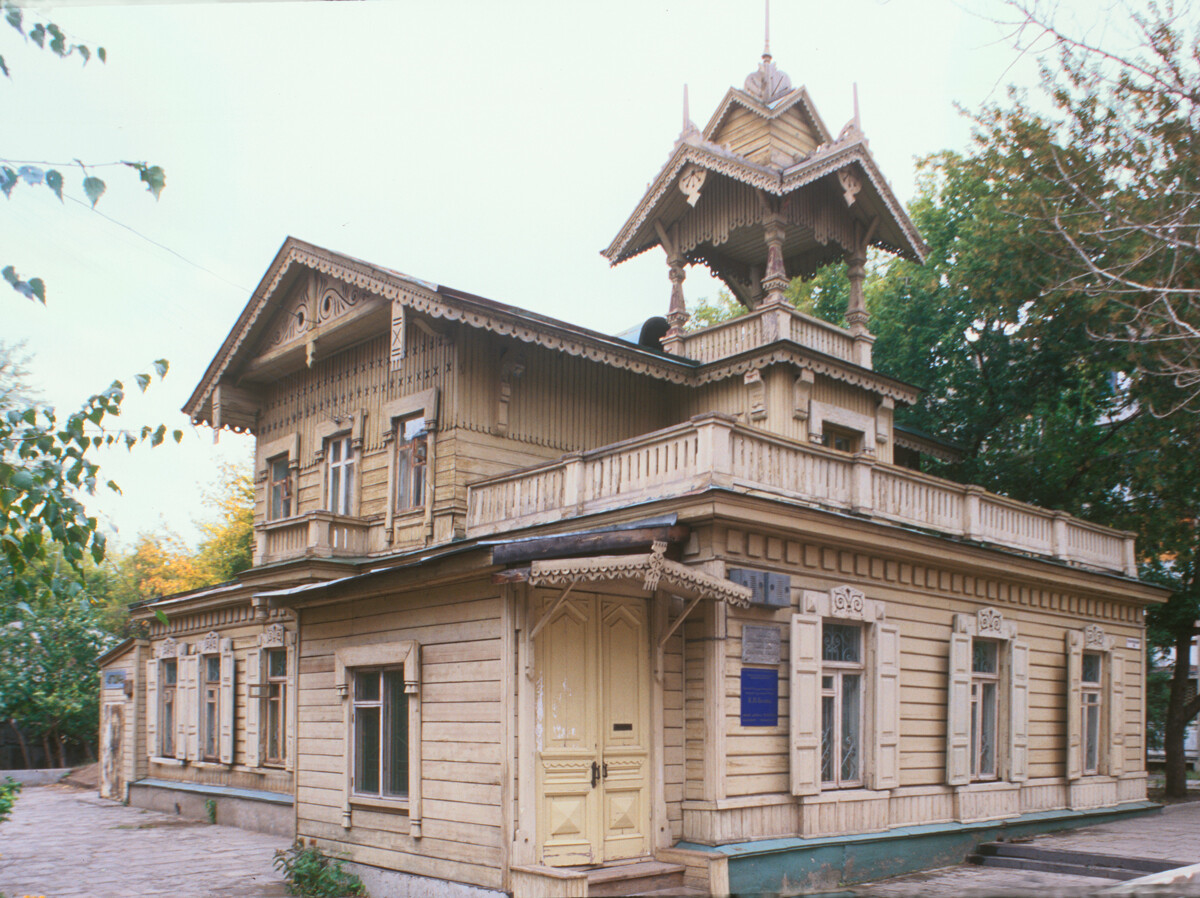
Philip Shtumfp house (Valikhanov Street 10), built at turn of 20th century for a prominet agronomist, entrepreneur, civic activist. September 19, 1999
Development of the city’s military-industrial complex continued after the war and, by the end of the 1970s, the population exceeded 1,000,000 – a benchmark of major significance. Omsk also became a center of the oil and gas industry.
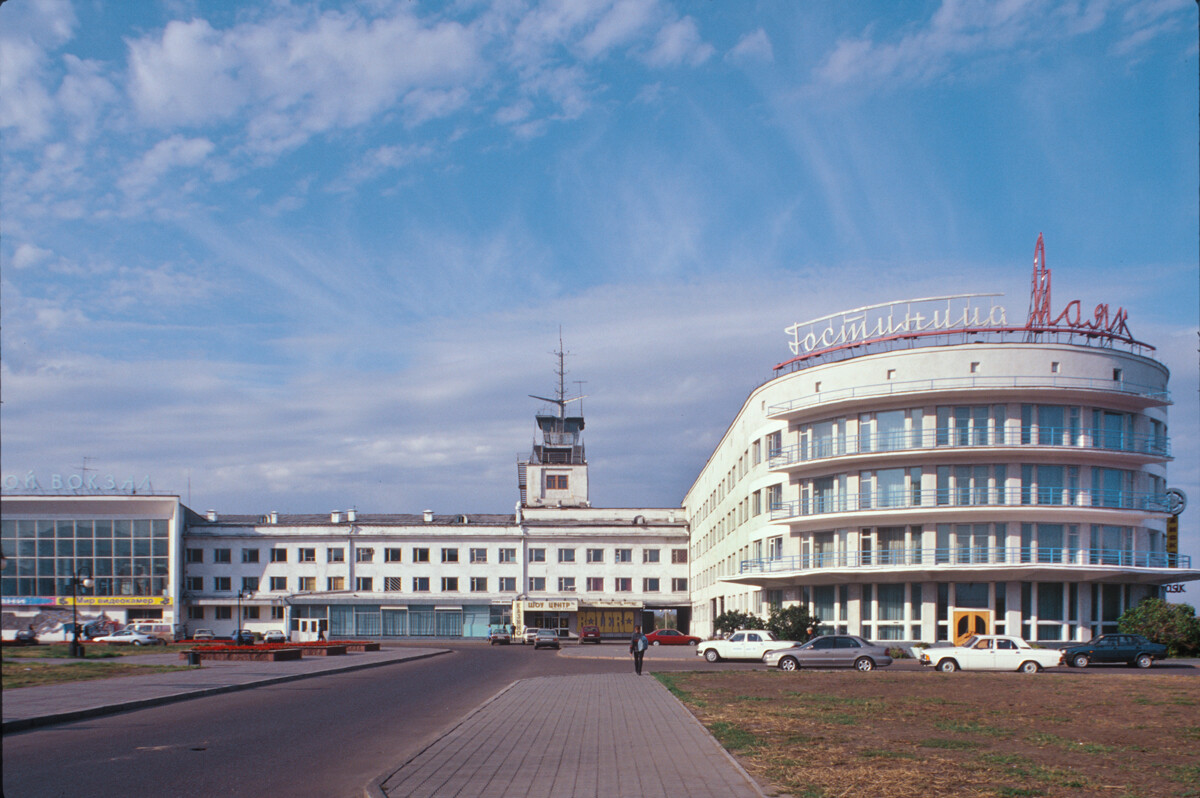
Omsk River Station & Hotel "Mayak". Excellent example of "neo-Constructivist architecture, built on site of original Omsk fortress in 1958-64 by Leningrad architect Timofei Sadovsky. September 15, 1999
The city’s major cultural institutions include a leading state university, established in 1974 and, since 2004, named in honor of Fyodor Dostoevsky. Omsk also has one of the largest regional libraries in Siberia and a major art museum--named in honor of painter Mikhail Vrubel, an Omsk native – that now occupies three landmark buildings in the center of the city.
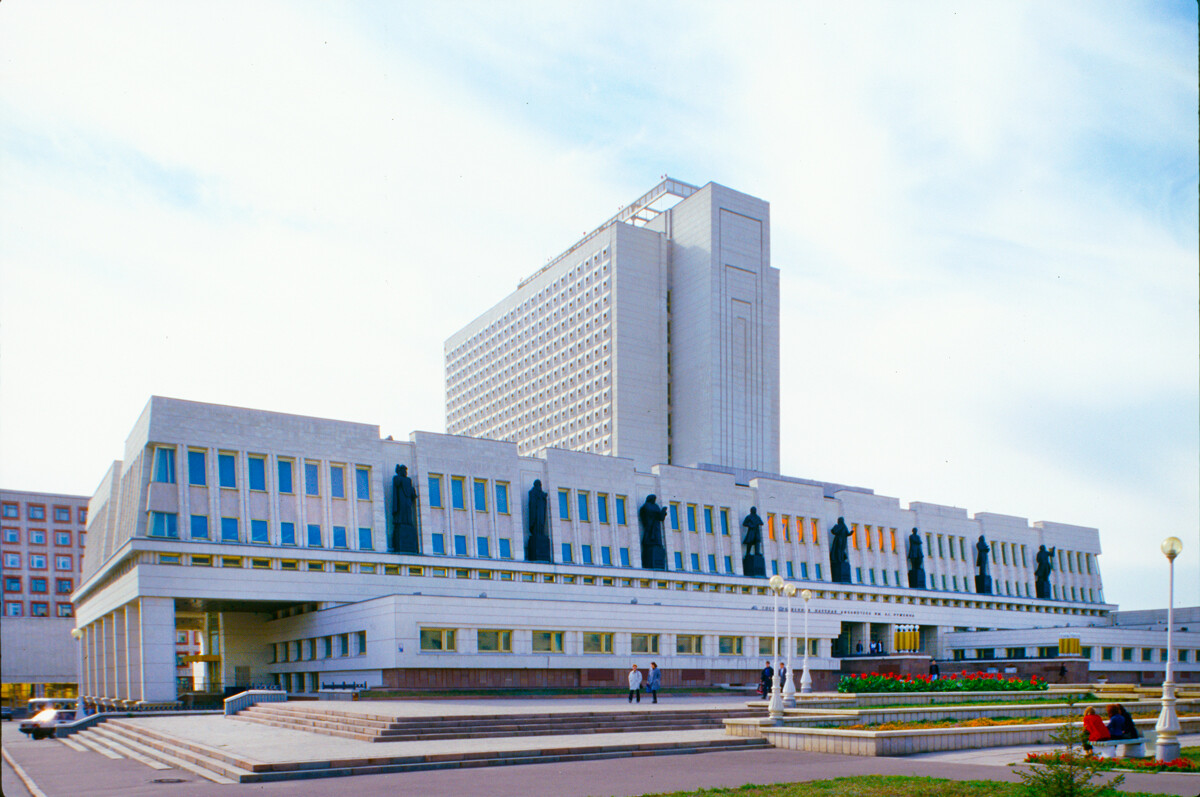
Omsk Regional Library. Built in 1986-95 by Omsk architects Galina Naritsina & Yury Zakharov. September 18, 1999
In the early 20th century, Russian photographer Sergey Prokudin-Gorsky developed a complex process for color photography. Between 1903 and 1916, he traveled through the Russian Empire and took over 2,000 photographs with the process, which involved three exposures on a glass plate. In August 1918, he left Russia and ultimately resettled in France, where he was reunited with a large part of his collection of glass negatives, as well as 13 albums of contact prints. After his death in Paris in 1944, his heirs sold the collection to the Library of Congress. In the early 21st century, the Library digitized the Prokudin-Gorsky Collection and made it freely available to the global public. A few Russian websites now have versions of the collection. In 1986, the architectural historian and photographer William Brumfield organized the first exhibit of Prokudin-Gorsky photographs at the Library of Congress. Over a period of work in Russia beginning in 1970, Brumfield has photographed most of the sites visited by Prokudin-Gorsky. This series of articles juxtaposes Prokudin-Gorsky’s views of architectural monuments with photographs taken by Brumfield decades later.
If using any of Russia Beyond's content, partly or in full, always provide an active hyperlink to the original material.
to our newsletter!
Get the week's best stories straight to your inbox
- U.S. professor continues photographic legacy of Prokudin-Gorsky in new book
- Exploring the Stroganov Baroque in the Russian North
- Taltsy: Preserving folk architecture in the Lake Baikal area (PHOTOS)
This website uses cookies. Click here to find out more.

IMAGES
COMMENTS
This programme has recently started new openings for veterinary nurses - final year SVNs and RVNs. The cost for veterinary nurses is £300 deposit + £350 - this cost covers full course fee and disposables, hotel, travel to and from the rescue/hotel daily.
The Travelling Vet Nurse . Pet Sitting and Vet Nurse Services. Vet Nurse Services. Pet Sitting. PAWfect Wedding Day "Vet nurse care, in the comfort of your pet's home" Get in contact today! Contact Me Location and Contact. Service areas . Melbourne. Summer - 0403 649 709. [email protected].
I'm Summer, and I have worked as a qualified veterinary nurse for 14 years in multiple clinics. I founded The Travelling Vet Nurse to provide professional animal care services in the comfort of the pets home, while also making life more convenient for owners! I have seen the need for more in-home care for animals.
Home Euthanasia. Hello, Thank you for entrusting us with such a special and precious time for you and your pet. My name is Summer and I am the founder of The Travelling Vet Nurse. I am a Senior Qualified Veterinary Nurse with over 14 years experience. I opened The Travelling Vet Nurse in June 2020 as I saw the need for pet care within the home.
The Travelling Veterinary Nurse. 1,283 likes. I am Lucy, a registered veterinary nurse who works in referral and emergency practice in the U.K. and travels around the world volunteering with...
Hi there, I'm Lauren the Travelling Vet Nurse! Having been a Veterinary Nurse for more than 10 years in various clinics around Western Australia, the Travelling Vet Nurse was born when my Husband and I decided to uplift our young family from our home in Geraldton and travel around Australia for six months in our caravan. My experience ranges ...
Hi! I'm Summer, and I have worked as a qualified veterinary nurse for 12 years in multiple clinics. I have founded The Travelling Vet Nurse to provide professional animal care services in the...
The Travelling Veterinary Nurse - Youtube Channel. Vet Med Traveller Merch! Let's Travel - Vet Med Style // Podcast! The Travelling Veterinary Nurse - Blog. Vet Talk - Guest Blog - Volunteering Abroad for the First Time. ERHAM Fundraiser - Vaccination and Sterilisation.
If you're specifically for jobs in Australia, by applying for the Work and Holiday visa, you'll become eligible to work and live in Australia for at least 1 year. Other working holiday visas are available for New Zealand and Japan. . A day at the office is full of exotic patients. . 3. Discuss your pay & benefits.
The Travelling Vet Nurse. The Travelling Vet Nurse. 3,274 likes · 1 talking about this. * Home Pet Euthanasia *Qualified Senior Vet Nurse *Pet Sitting *Dog Wedding Chaperone...
Here are the steps I took to become a traveling veterinarian and what I learned along the way: 1. Relief work: a gateway to veterinary work across the country. To initially dip my toe into the relief pool, I started working for a relief veterinary group in 2021 that provided me benefits and allowed for easy scheduling at a select group of ...
I am a qualified senior veterinary nurse with 15 years' experience in veterinary practices, and will make your pet feel safe and secure in their own home with one-on-one care and love. ... Summer - 0403 649 709. [email protected]. www.thetravellingvetnurse.com.au.
Vet Nurses and Techs are vital to their clinics- lets find out how and why we need to legally recognise their skills and expertise through title protection. Read More. There are plenty of opportunities out there for vet nurses and vet techs to work, volunteer and travel internationally with their skills. Find out how you can get involved!
1. Alert Your Recruiter as Early as Possible. The most important tip for travel nurses with pets is to let your recruiter know that your best friend is coming with you - and the more advance notices the better. This will allow your recruiter ample time to find pet-friendly housing. Free housing is a great travel nurse benefit, but most ...
For the veterinary experience project, no prior qualifications or experience are required. Oyster also offers a more advanced internship programme in South Africa that is designed to give you a hands on experience in treating and working with a range of animals on game reserves, farms and clinics. It can be done as part of a gap year, a summer ...
Compass Healthcare Consulting & Placement is conducting a search for an experienced Registered Nurse, RN, for a primarily Remote position as a UAS Trainer / Quality Assurance UAS Review RN. Qualified candidates will have prior UAS-NY RN experience, have an active HCS account, ability to train other Registered Nurses on UAS-NY and complete ...
Tours Add a Place Travel Forum Airlines Travel Guides Help Centre Travel Articles. Europe. Russia. Siberian District. Omsk Oblast. Omsk. Things to do in Omsk. Nature & parks in Omsk. ... There are lakes in which to enjoy a summer swim, and many places of interest either next to the river or in the central area. A great day out!
The Travelling Vet Nurse . Summer. 0403 649 709. [email protected] . Please check your junk mail if you haven't received an email from me within 48 hours. Thank you! ... Thank you for contacting The Travelling Vet Nurse! I will be in contact shortly. Warm Regards, Summer. The Travelling Vet Nurse. Get in contact today ...
Omsk is one of the largest cities in Russia, a major scientific, cultural, sports, transport, and industrial center. The administrative center of Omsk Oblast, it is the second most populous city in Siberia. The population of Omsk is about 1,126,000 (2022), the area - 567 sq. km. The phone code - +7 3812, the postal codes - 644000-644246.
Omsk was founded in 1716 when a wooden fort was constructed to house a Cossack unit in the area to protect the expanding Russian frontier from Central Asian nomadic incursions. It served various ...
The Travelling Veterinary Nurse is not legally able to diagnose medical issues and conditions, prescribe medications or administer vaccinations. I can offer general advice and recommendations, however this does not replace the diagnostic and professional ability and expertise of a veterinarian. ... Summer - 0403 649 709. summer ...
September 15, 1999. William Brumfield. Omsk (current population around 1,110,000) was founded in 1716 as a fort on the middle reaches of the Irtysh River. During the 18th century, its primary ...